Mayan history and successful business


A look at the varied research at Northeast Ohio’s colleges and universities
BY RACHEL ABBEY MCCAFFERTY
Northeast Ohio’s colleges and universities aren’t just for educating the next generation.
ey’re also for helping to de ne and explain the future — and the past — through their groundbreaking research.
Academics at the region’s higher education institutions are engaged in a wide variety of research, in elds ranging from health care to polymer science to economics. What follows is just a small sample of the projects professors and students are devoting their time, energy and expertise to. And check back next week for another round of interesting local research.

Developer buys Richman Brothers Co. factory
New York company has an eye on preservation
 BY MICHELLE JARBOE
BY MICHELLE JARBOE





A New York developer has purchased the mammoth Richman Brothers Co. factory on Cleveland’s East Side, in a quiet deal that eventually could bring new life to one of the city’s largest eyesores.
An affiliate of CMI Developers LLC bought the 638,000-squarefoot building, which sits on 6 acres along East 55th Street, in late August. But the sale did not appear in public records until Wednesday, Nov. 9. There’s no price listed for the property, which hit the market in late 2020
at an asking price of $3.5 million. CMI, which shares an address with New York-based Carnegie Management, avoids the limelight. e company provided a brief statement in response to an inquiry from Crain’s.
“CMI Developers LLC is excited to pursue the redevelopment of the Richman Brothers factory building,” the company wrote. “ e building is one of Cleveland’s historic treasures, and its rebirth will serve as a catalyst for the revitalization of the city’s East Side.”

VOL. 43, NO. 42 l COPYRIGHT 2022 CRAIN COMMUNICATIONS INC. l ALL RIGHTS RESERVED NEWSPAPER CRAINSCLEVELAND.COM I NOVEMBER 14, 2022 REAL ESTATE
up e orts to bring women
construction
PAGE 10 CRAIN’S LIST: Revenue bounces back for nonpro ts that bring crowds. PAGE 22
Ramping
into
careers.
KEN BLAZE FOR CRAIN’S CLEVELAND BUSINESS THE LAND SCAPE A
CLEVELAND PODCAST
Employers say exibility has been key to building and keeping their workforce in a changing jobs market.
PAGE 16
CRAIN’S
See RESEARCH on Page 26 See RICHMAN on Page 25
Malone University has a variety of projects to teach students about how the health of local watersheds a ects the oceans. | COURTESY OF MALONE UNIVERSITY
Pot companies look to legalization, reforms to boost business
JEREMY NOBILE
As marijuana companies work through a business downturn amid surging in ation, a buildup in supply and simultaneous decreases in pric es and sales, stakeholders are looking all the more hopefully at a number of policy changes at state and federal levels that could bene t the industry.
Key among these is legalization of recreational use, which would make marijuana accessible to all adults age 21 and older — something that would signi cantly expand the potential marijuana customer base in Ohio’s medical-only market.
“ e Ohio market was seen as a bull market for some time, and that may be fading to some degree right now,” said Douglas Berman, execu tive director of the Drug Enforcement and Policy Center at Ohio State Uni versity. “ at may amp up the pres sure internally or externally to press forward on some other reform bills.”
In addition to legalization e orts, there are a number of other pending policy changes in motion that could stand to bene t businesses and con sumers.
Federal legalization
At least 68% of Americans want marijuana to be legalized at the fed eral level, according to the latest Gal lup survey.
However, the recent midterms were a mixed bag in terms of building further momentum behind that.
While voters in Maryland and Mis souri approved recreational marijua na — bringing the number of states permitting adult use to 21 — similar measures failed in Arkansas, North Dakota and South Dakota.
Despite marijuana’s clearly grow ing popularity, those results indicate that not everyone is on board with adult access to legal weed just yet, which could in uence how much federal lawmakers prioritize mari juana descheduling and legalization.
Berman notes that even if marijua na were federally descheduled, rec reational access wouldn’t happen instantly. ere will likely be a windup period, perhaps something be tween one month to one year, built into any change in federal policy to allow states to adjust and set their own rules.
Ohio legalization bills wither
Two separate legalization bills were introduced in Ohio by Demo crats (House Bill 382) and Republi cans (House Bill 498) in 2021.
Each has been touted by their backing lawmakers as drawing bipar tisan support, though no one seems to be working together across the aisles on either.
Both have seen zero activity since being introduced to the House Fi nance Committee roughly a year ago.
Ohio’s marijuana industry stake holders tend to say that is disap pointing but not surprising, consid ering the state of Ohio’s legislature and given that the proposed laws have been sitting dormant for so long.
“It’s a good thing lawmakers are talking about this,” remarked one marijuana industry o cial. “But I don’t think leadership has any inter est in taking on either of those bills.
Enacted statute stalls
e enacted statute introduced by a group known as the Coalition to Regulate Marijuana Like Alcohol, which aims to establish a recreation al marijuana program in Ohio, had some momentum this year before hitting some snags. But it will be back in motion in 2023.
at measure must draw a certain number of voter signatures to be in troduced into the General Assembly. Once that happens, lawmakers have four months to pass or reject the pro posal.
If they reject it or refuse to take ac tion — the more likely outcome — the CRMLA must collect a second tranche of signatures to bring the measure before voters.
e CRMLA coalesced to work on its legalization e ort in 2020. e idea was to be on the ballot in the presidential election year when voter turnouts are highest.
But the COVID-19 pandemic cre ated unforeseen challenges with col lecting voter signatures that typically would be gathered at public events, which were largely shut down, or by knocking on doors.
In early 2022, the CRMLA submit ted its rst petitions to the secretary of state for veri cation. Some signa tures were rejected. So, the CRMLA mobilized, made up the di erence, re-submitted its petitions and got the OK to be handed over to the General Assembly.
It was expected the proposed law would sit until four months elapsed in late May. At that point, the group could gather more signatures to qualify for the fall ballot.
However, Ohio Republicans led a lawsuit challenging whether the CRMLA met a January deadline for submitting its measure in order to be considered by lawmakers this year.
While CRMLA delivered its rst peti tions before that deadline, the group came back with its additional signa
Who's funding the Coalition to Regulate Marijuana Like Alcohol?
Between 2021 and 2022, the CRMLA, which is pursuing marijuana legalization in Ohio through an enacted statute, has received more than $1.5 million in contributions supporting its e orts. The group's top donor is the Marijuana Policy Project, a Washington, D.C., legalization advocacy group that nances legalization campaigns across the country. All other contribu tions come from licensed marijuana businesses in the state.
Here's who has given to the CRMLA campaign in the last two years:
` Marijuana Policy Project: $840,000
`
`
Battle Green Holdings: $160,000
The Firelands Co.: $160,000
` ATCPC of Ohio: $155,000
`
`
Standard Wellness Co.: $105,000
Buckeye Relief: $50,000
` Riviera Creek: $37,500
tures replacing the disquali ed ones after that.
Tom Haren, CRMLA spokesman and chair of Frantz Ward’s cannabis law group, was prepared to ght the lawsuit on the grounds that there is to be a remedy period to correct the is sues with the signatures, which he said it was within.
Instead of ghting in court, though, both parties settled.
e deal that was struck kept the enacted statute o this year’s ballot in exchange for the secretary of state carrying over previously OK’d peti tions and re-transmitting the CRM LA’s proposed law to the General As sembly on Jan. 3, 2023.
at settlement puts the CRMLA on track to begin collecting its sec ond tranche of signatures next spring in order to qualify for the 2023 ballot.
While marijuana businesses would like to see a rec program soon er rather than later — a few have con tributed signi cant levels of funds to the CRMLA campaign — Haren is not worried about the setback.
“ e rule of thumb tends to be that if it is a progressive ballot campaign, it needs to come in a general election year, because in o years, you tend to have a more conservative electorate,” Haren said. “But if there is one thing we think polling has shown, it is that legalization is popular across the po litical spectrum. For an issue like ours, you always want high turnout. But we think our initiative does just as well in 2023 as it would have done in 2022.”
Medical program overhaul
In fall 2021, Sen. Stephen Hu man, R-Tipp City, lead sponsor of House Bill 523 — which set the framework for the Ohio Medical Marijuana Control Program (OM MCP) when it was passed in 2016 — and co-sponsor Sen. Kenny Yuko, D-Richmond Heights, introduced Senate Bill 261. If passed, it would be the rst major overhaul of the state’s medical program since its inception.
One of the bill’s key features is put ting regulation of the medical pro gram solely in the hands of the Ohio Department of Commerce.
Under the current regulatory scheme, Commerce regulates culti vators, processors and testing labs.
e Ohio Board of Pharmacy over sees dispensaries. And the state medical board awards physicians their certi cates to recommend mar ijuana.
is dynamic with Commerce and Pharmacy, in particular, has been criticized by marijuana companies as ine cient and onerous. It has been blamed as one of the factors contrib uting to retail costs that are higher here than in neighboring markets and one of the reasons the program is
slow to adapt to changes.
But there are many other aspects of the OMMCP the bill could change. e law would add new qualifying conditions such as migraines, autism spectrum disorder and opioid-use disorder, as well as give broad au thority to physicians to recommend marijuana for any condition that could “reasonably be expected to be relieved” by the drug. All these things could greatly expand marijuana’s customer base.
e bill could loosen tight restric tions on advertising and allow for new products currently unavailable in Ohio like pills, suppositories and inhalers. It also would increase the limit on the concentration of THC in products from 70% to 90%.
ese things bene t patients and could lead to more sales, bene ting businesses.
But there are some more contro versial aspects of the bill, as well, such as a provision that awards culti vation licenses to some standalone processors, including those that were previously disquali ed for licenses by the state.
is includes Cincinnati business man Jimmy Gould, owner of mari juana processor CannAscend, who was among those who sued the state for not being awarded a cultivation license in 2018.

Many current license holders are reticent to discuss these more con troversial aspects of the bill publicly. But to be sure, there are some an noyed that there could be business people awarded lucrative grow li censes through this law after they had to secure theirs through a com petitive and expensive application process.
ere is talk in some industry stakeholder circles of potentially pushing for having some of these more controversial elements of the bill taken out. Whether they are or not could play a role in whether that bill sees any further action before the end of this year.
Jeremy Nobile: jnobile@crain.com, (216) 771-5362, @JeremyNobile
2 CRAIN’S CLEVELAND BUSINESS | NO VE M BER 14, 2022 MARIJUANA
Especially (the Democratic) bill. Ev eryone knew that was going no where.”
Plants in a grow room at Standard Wellness Co.’s Gibsonburg cultivation facility. CONTRIBUTED
11/11
Honoring those who serve 24/7
With over 200,000 veterans and service men and women reentering the workforce each year, Bank of America is supporting the unique needs of our heroes as they transition to civilian life and careers.
Some steps we’re taking to support veterans and military members:


• Offering free online resources through BetterMoneyHabits.com on topics specific to them, from home buying to retirement
• Expanding the number of financial centers near military installations to address the needs of military customers
• Continuing our hiring momentum — more than 15% of our new hires are military veterans
My teammates and I here in Cleveland are proud to support our military service men and women, especially as we celebrate Veterans Day. Thank you for your service.
Marziani President,
Bank of America, Better Money Habits, Mejores Hábitos Financieros and the Bank of America logo are registered trademarks of Bank of America Corporation. Bank of America, N.A. Member FDIC. Equal Credit Opportunity Lender © 2022 Bank of America Corporation. All rights reserved.
would you like the
to do?
What
power
® Learn more at bankofamerica.com/cleveland
Jeneen
Bank of America Cleveland
Global Cleveland launches Global Entrepreneur in Residence program


 BY KIM PALMER
BY KIM PALMER
Every year, hundreds of thousands of skilled immigrants apply to work in the U.S. through one of the country’s highly competitive H-1B visas. e lottery process for the visa that allows U.S. businesses to temporarily employ skilled foreign workers is so intense that only 26% of those applicants snagged one of the 85,000 coveted spots set aside for 2023.
“We heard from many talented people who were applying for H-1B visas but were getting denied here in Northeast Ohio,” said Joe Cimperman, president of Global Cleveland. “We know that we need this incredible talent we can tap. But the visas are so competitive, and companies don’t want to deal with them because they think it is too complicated, too expensive.”
Cimperman argues the country’s immigration process, including the H-1B visa program, is failing to live up to the goal of attracting and retaining STEM talent the region so desperately needs.
at line of reasoning led to Global Cleveland to partner with Cleveland State University to sponsor a unique type of H-1B visa through what’s called the Global Entrepreneur in Residence (GEIR) program.





GEIR is designed to help foreign-born entrepreneurs gain access to visas — in this case, a research university-sponsored H-1B visa that will allow them to develop and grow their businesses in the U.S.
“ is GEIR program, which is the rst of its kind in the state, is a remedy to an intentionally broken H-1B system,” Cimperman said.
work-authorization requirement while doing the work to build their business.
“We have to pay for their H-1B filing process and for the lawyers, and then we have to pay the founders who are employed by us and help with promoting the program in exchange,” said Supriya Tamang, Global Cleveland’s program training and development manager, as well as the lead on the GEIR program.


The program is focused on, but not limited to, foreign STEM students who graduate but want to remain in the country and are wary of taking their chances with the 85,000 national limit on employer-based H-1B visas.
GEIR also provides more flexibility than traditional H-1B employer-based programs, which closed out 2023 applications in late August of this year.


“This program is separate from the other lottery,” Tamang said. “Applicants don’t have to go through that process, and unlike other programs, they can file for this at any time of the year.”


Raising capital, creating jobs

For the rst phase of the GEIR program, Cimperman said Global Cleveland is looking to raise around $300,000 to help fund 10 entrepreneurs, or “founder” visas.
Each city’s GEIR program is unique. Some programs only sponsor tech or STEM-based companies. Under the visa guidelines, recipients have two years to show their business is viable.
could transfer applicants to some of the newer programs like ours,” she said.

One of the newer GEIR programs nationwide, launched three years ago in Detroit, now sponsors eight entrepreneurs who have raised more than $15 million to date and created more than 50 jobs in the region.
Aaron George and SupplyNow



Global Cleveland sta had discussed the entrepreneur program as a means to bring more skilled visas to the region before nearly all immigration was halted during the pandemic.

But when Aaron George — who was looking for a way to keep his company, SupplyNow, in Northeast Ohio — approached the organization, Cimperman said he knew they would be able to sell the program to funders.
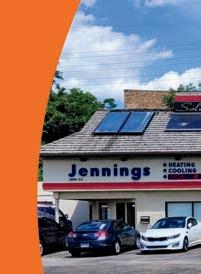
“Aaron is the real deal. With him, we had a real-life example of how this program could work,” Cimperman said.

George, a civil engineering and business management graduate from Case Western Reserve University, stayed in Ohio under the school’s optional practical training program, which allows for post-graduate employment for international students.


During and after graduation, George worked on a number of meal and food-related business ideas, eventually settling on the concept behind SupplyNow, a procurement-based restaurant supply and food service delivery company.
e U.S. is one of the only developed countries without a dedicated entrepreneurial or startup visa program aimed at attracting immigrant entrepreneurs.
“With our particular program, we are giving our founders about two years, and then after that if the business is growing, they can move on to the next path,” Tamang said. “And if they have not raised enough capital and not enough growth has occurred, we would have to let the founder out of the program.”
His business is lling a niche resulting from workforce shortages within the restaurant and food service industry.
“We can get all your supplies shopped and delivered at a competitive rate to your food distributor within one to three hours if needed,” George said.
The first GEIR program came out of a partnership between the University of Massachusetts and the state, focused on Boston. Since 2015, similar GEIR programs have been established in Anchorage, Alaska; Boulder, Colorado; Detroit; St. Louis; and San Jose, California. The partnership uses the exemption given to research universities to sponsor an unlimited number of academic H-1B visas with public and private funding to create an entrepreneurial pathway for foreign-born entrepreneurs, or “founders.”
With the Cleveland program, CSU is the sponsor for visa applicants, and Global Cleveland manages and raises funds to enable the entrepreneurs to meet the

Tamang said successful entrepreneurs in residence will be able to apply to springboard from the GEIR program to either a green card or to business-based visas available to foreign investors, which require around $250,000 in equity.
The entrepreneurs in the program also are required remit a percentage of the business’ revenue back to the “community” as a part of the visa agreement.
Making, not taking, jobs
In the less than a decade, Boston’s GEIR program has 81 sponsored entrepreneurs who in total have raised $1.5 billion in venture capital and created 2,500 new jobs.
There is so much demand for more resident entrepreneurs in Boston, Tamang said, that the program cannot keep up with push of applicants and investors who want to be part of this program.
“Boston has actually asked if they
George now has 18 employees and has gone through multiple rounds of successful venture capital fundraising. As part of his work, he goes out into the community to raise awareness for the GEIR program.
Lots of competition

Attracting and retaining the best STEM talent is both a national security and economic imperative, according to Steve Stivers, president and CEO of the Ohio Chamber of Commerce.
Stivers points out that with startup visa programs in Canada and China, the U.S. will have to reform immigration to compete. He supports Global Cleveland’s work and has come out in support of a bill in Congress, America COMPETES (H.R. 4521), that would support and help to attract immigrant entrepreneurs.

“Entrepreneurial visas are just as important as worker visas, because entrepreneurs in our state increase investment and jobs and improve the overall economy,” Stivers said.
Kim Palmer: kpalmer@crain.com, (216) 771-5384, @kimfouro ve
4 CRAIN’S CLEVELAND BUSINESS | NOVEMBER 14, 2022 11,146 SF • Multi-Purpose Flex Drive-in Doors • 6 Private Offices • Large Training Room w/ Kitchenette Show Room • Solar Backup Power • Great Highway Access (I-76 & I-77) 10,600 VPD • Newly Renovated FOR SALE/LEASE 1671 East Market Street, Akron, Ohio 44305 $425,000 • $38.13 PSF Tyler Robin Associate Advisor 330.591.7974 tyler.robin@svn.com Aaron Davis Senior Advisor 330.221.7297 aaron.davis@svn.com FOR SALE: LAND IMMEDIATELY OFF I-80 WWW.HANNACRE.COM Silica Road & State Route 46, Austintown, OH 44515 330.958.7291 johnlubinski@hannacre.com John Lubinski 2 Highly Visible Land Parcels 1/4 Mile From I-80 22,500 VPD on North Canfield Niles Road Across from Hollywood Casino Entrance THE KEY TO YOUR LOAN PROVIDING COMMERCIAL REAL ESTATE LOANS THROUGHOUT NORTHEAST OHIO CONTACT JONATHAN A. MOKRI 440.526.8700 jmokri@cbscuso.com www.cbscuso.com Straight Talk, Smart Deals ® Personalized Service! • Loans up to $30 Million • No Prepayment Penalties • Investment & OwnerOccupied Commercial Real Estate GOVERNMENT
No easy road for foreign founders
Tamang
“THIS GEIR PROGRAM, WHICH IS THE FIRST OF ITS KIND IN THE STATE, IS A REMEDY TO AN INTENTIONALLY BROKEN H-1B SYSTEM.”
—Joe Cimperman, president of Global Cleveland
MY BENESCH
NOAM
Featured team (left to right)
JEFFREY J. WILD
ADAM N. SAURWEIN




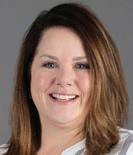




DANIEL S. MUROW


SHANNON LIGETTI*
LESLIE A. DROCKTON
BARRY J. GUTTMAN
JARED KRIWINSKY
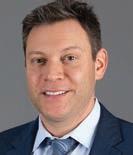
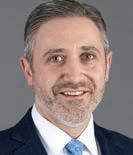

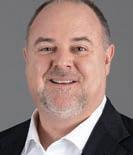
CHRISTOPHER M. MATGOURANIS

MICHAEL W. WARD

ALISON EVANS
ELLIOT M. SMITH
DANA WEISS
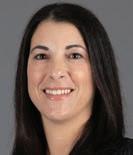
JENNIFER L. KATZAKIS
JACKSON SATTELL

KEVIN D. MARGOLIS
JARED E. OAKES
ROSS J. KIRCHICK
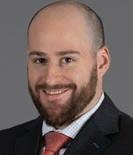
LEE KORLAND
M. CASEY KUCHARSON
MICHAEL D. STOVSKY
THOMAS O. CRIST
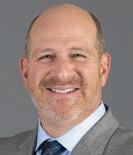
*Paralegal
MY TEAM
When executing 20 or more multifamily development projects from the ground up every year, time becomes the most valuable asset. Noam and his legal team rely on Benesch to keep complex real estate transactions moving forward, which includes spotting issues and also analyzing, advocating, advising, and ultimately helping to get deals done. From initial joint venture and operating agreements to project financing to eventual sale of completed developments, Benesch brings in-depth industry insight, NRP-specific knowledge, and a practical, results-focused approach—deal after deal.
What can we build together with your team? Learn more about our relationship with NRP Group at beneschlaw.com/myteam.
www.beneschlaw.com
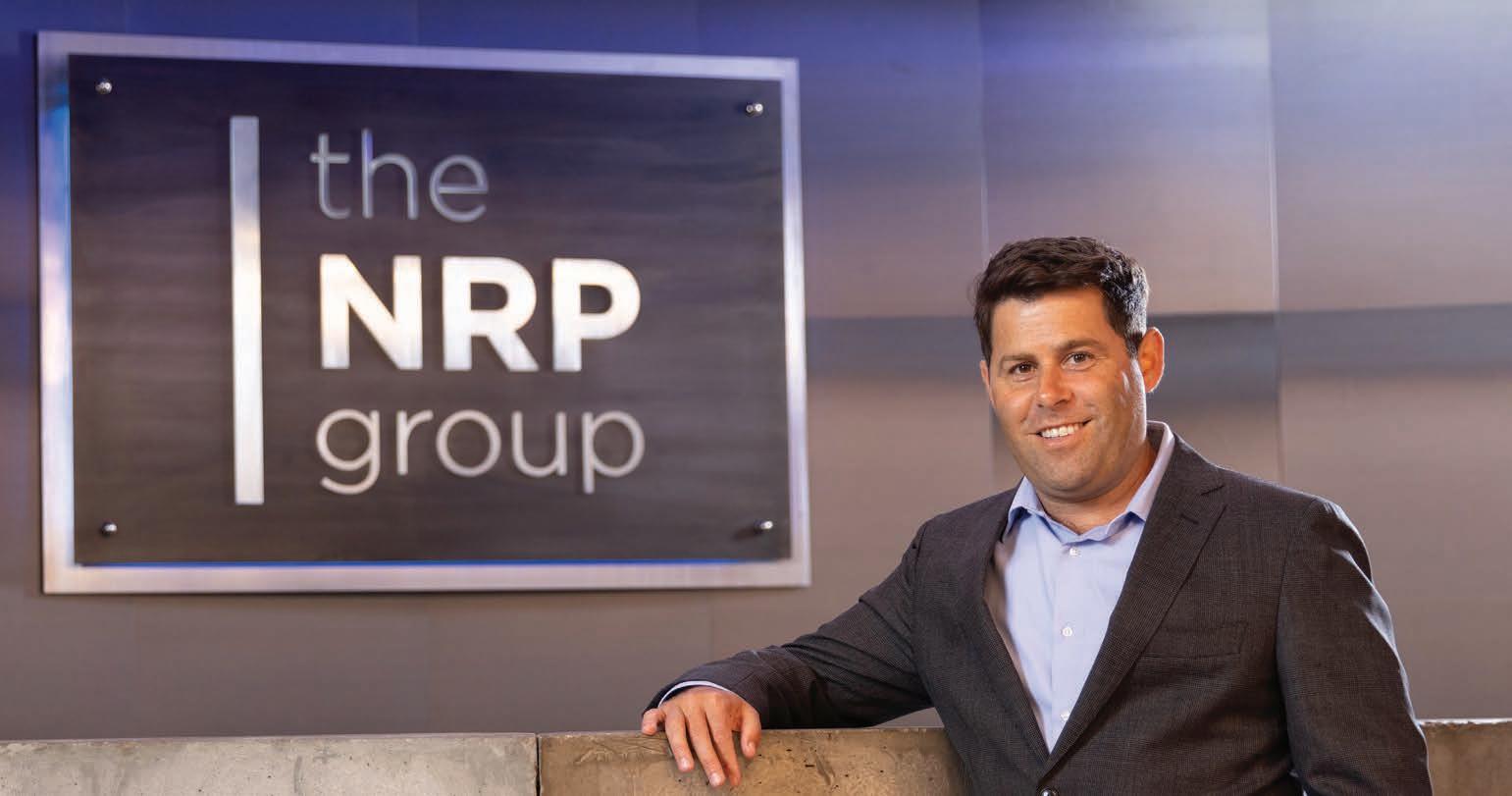 © 2021 Benesch Friedlander Coplan & Aronoff LLP
© 2021 Benesch Friedlander Coplan & Aronoff LLP
“Benesch is very aware of the value of time. When giving counsel, they cut through the clutter to highlight the most important issues. They don’t get lost in the weeds. In our highvolume fast-paced environment, that makes all the difference.
MAGENCE Principal, Executive Vice President and General Counsel NRP Group
Tim VanNewhouse looks to give boxing a puncher’s chance
JOE SCALZO
To Tim VanNewhouse, Cleveland’s reputation as a boxing town has tak en a hit for one reason: ere’s very little boxing in town
“We think there’s a big void in pro viding a consistent platform for younger athletes to develop their ca reers,” said VanNewhouse, a Cleve land native and longtime boxing manager who earlier this year formed his own management company, Ne whouse Boxing. “ at’s why you see most of the ghters from this region leave or walk away from the sport.
“ ere’s something wrong with that. We have a rich history of pro ducing top talent, but there’s not a deep connection in the community to the sport or the athletes.”
VanNewhouse plans to change that, starting Dec. 16 when New house Boxing presents “A Night to Remember” at LaCentre Conference and Banquet Facility in Westlake. e card will feature three of Cleveland’s top boxing contenders: Antonio Nieves (20-3-2, 11KOs), Michael Moore (19-3, 8KOs), and Mark Davis Jr. (18-1, 5 KOs), as well as newcomer Abdullah Mason (4-0, 3KOs).
“It’s our rst event under the New house brand, but it’s something we look forward to producing on a con sistent basis,” VanNewhouse said.
“(Cleveland-area promoter) Tom Vacca was the one who harnessed our market, but after he retired, we haven’t seen consistent, successful club-style events. We plan to change that by having events like these.”
Here are four things to know about the event:
1. It’s at an upscale venue. To some, the phrase “club boxing show” conjures images of a smoky,



rowdy convention hall from the 1930s. LaCentre isn’t like that. e 22,000-square-foot conference and banquet facility is advertising a Ve gas-like experience for the show, one with “elegance and class.”
e ticket prices re ect that, with the cheapest general admission seat going for $50.


“When I rst stepped foot into the facility, I saw the potential for hosting sporting events like boxing and wres tling and dance competitions,” said LeVoy Hospitality Group CEO and president Jonathan LeVoy, whose company leased the facility in late

December. “It’s a great space and it has the opportunity to do a lot of dif ferent things. We don’t want to be pi geonholed into just doing weddings and graduations and corpo rate-minded events.”
LaCentre is one of the largest facilities of its kind in Cleveland, capable of holding 1,000 fans for a boxing show.
“What I keep hearing from our guests is that our space o ers a lot that other spaces don’t. It has a lot of personality,” LaCentre GM Edie Smith said. “It doesn’t have blank walls. It’s a very comfortable, hometype feeling. at lends itself to a va riety of di erent things, as opposed to just weddings.”
For VanNewhouse, choosing an upscale venue isn’t new. When he rst started producing shows in Cleveland in 2009, he often picked higher-class venues such as La Villa Conference and Banquet Center on Brookpark Road in Cleveland.










“ is is like La Villa on steroids,” VanNewhouse said, laughing. “We’re really excited about it.”


2. Early sales are strong.




VanNewhouse initially o ered 22 VIP tables (seating six) around the ring. Each table cost $1,000. ey sold out within a week.
So, he ended up removing 160 general admission seats and re placed them with high-top tables that seat four. Each table costs $600. As of Tuesday, Nov. 8, he had four left.
“ e response has been incredible,” he said. “I’ve always been a big believ er that success doesn’t have to be a numbers game. We don’t need a big convention hall lled with the masses. To get our message through, we have to have a quality event featuring a smaller, more targeted audience.”


3. It has sponsor support.
e event will be livestreamed by BigPlay.com, which calls itself the fastest-growing live sports network in Cleveland. e site hosts “ e Bernie Kosar Show” with Hanford Dixon and boasts more than 1.3 million fol lowers across its social media ac counts. Other sponsors include Westlake-based Ground Works Land Design and Kleinhenz Jewelers, as well as global boxing leader Everlast Worldwide. LaBatt Blue is the beer sponsor.
VanNewhouse also sees a lot of po tential in teaming up with a sports book once legalized sports gambling arrives in Ohio on Jan. 1.
“ at could be a prime opportuni ty for us,” he said. “We’ve been in talks with several of those organiza tions who can partner with us once we do these consistently.”

4. It is (he hopes) the rst of many.
VanNewhouse initially wants to of fer shows twice a year, then possibly expand to four events a year. He be lieves there’s an appetite for live box ing in Cleveland, but it needs to be nurtured.
“I believe that we can create a bond strong enough to generate box ing fans for events to come,” VanNe whouse said. “We think this is the perfect opportunity to introduce the sport to fans who wouldn’t otherwise see it or otherwise be interested.” Joe Scalzo: joe.scalzo@crain.com, (216) 771-5256,
6 CRAIN’S CLEVELAND BUSINESS | NO VE M BER 14, 2022 FOR YOU, OUR PURSUIT OF EXCELLENCE IS NEVER ENDING.
Let us
Member FDIC. © 2022 Northern Trust Corporation. INVESTING | BANKING | TRUST & ESTATE SERVICES | WEALTH PLANNING | FAMILY OFFICE 200 Public Square, Suite 3200, Cleveland BEST PRIVATE BANK BEST PRIVATE BANK BEST PRIVATE BANK FOR FAMILY OFFICES — GLOBAL FOR INNOVATION — GLOBAL U.S. Financial Times Group, 2022
Advice that builds on success. Service and technology that never stop getting better. Every day we pursue excellence with intent and purpose to be our clients’ most trusted advisor.
help you realize the full potential of your wealth, call Michael Cogan, 216-357-2439 or visit northerntrust.com/cleveland
SPORTS BUSINESS
@JoeScalzo01
Suburban o ce building hit with foreclosure proceedings
Failing to pay most of its property taxes since 2019 has landed the own er of a four- oor Westlake o ce building in a foreclosure proceeding led by Park National Bank of Cin cinnati.
Westlake 555 LLC, a Miami Beach investor group that owns the onetime King James O ce Park structure at 24650 Center Ridge Road, violated the terms of a $3.4 million loan the company used to buy the building, according to a lawsuit led Oct. 26 in Cuyahoga County Court of Common Pleas. Judge John O’Donnell has the case.
Keeping taxes current is a typical requirement for such bank loans. Failure to do so triggers what is known as a technical default because the borrower, according to court re cords, remained current on its pay ments. e building owner has paid a total of $64,000 in the last three years but owes unpaid taxes and fees total ing $218,000, according to county property tax records.
Westlake 555 acquired the build ing, which dates from 1976 and bears the name Westlake Center, in 2018 from Erie, Pennsylvania-based Westlake LLC for $4.3 million. Oper ated by Erie developer Tom Kenne dy, Westlake LLC had retenanted
the structure after buying it from Wells Fargo Bank in 2010 for $750,000.
Westlake 555, led by investor Da vid Gonen, had not led an answer to the lawsuit by Wednesday, Nov. 9.
In a post on LinkedIn accompa nied with pictures of the building’s interior in disarray, Gonen asked for investors to help him convert it to an 87-suite apartment building. Gonen did not return three calls from Crain’s Cleveland Business by 5:30 p.m. Wednesday.
Alex Jelepis, an executive vice president and director at NAI Pleas ant Valley realty brokerage in Inde pendence, said the building was full when Westlake 555 acquired it but lost its tenants over the years, a situa tion not helped by the COVID-19 pandemic.
Upper oors of the building are large, open spaces that would need signi cant upgrading, Jelepis said.
at is di cult, he said, because buildings of Westlake Center’s vin tage typically need to o er low rents and receive continued investments to remain pro table.
At one point, TA Operating LLC, the parent company of TravelCenters of America, which is headquartered across the street, leased two oors in the building. In July 2019, TA Operat ing sued the building owner to re
coup rent for 58 days because the structure’s sole elevator was not op erational. e lawsuit was settled out of court that August. Terms were not disclosed.
TravelCenters left the building several years ago, Jelepis said. He wonders if the building’s distress stems from the group trying to own and operate the building from out of town, but said he believes it could be a good t for the right business own er or developer.
“It has value from its site alone,” Jelepis said.
Although the vast parking lot and proximity to multistory residential condominium buildings could make it a residential play, there are hurdles
to such an undertaking because of the big bucks involved.
Jim Bedell, Westlake director of planning and economic develop ment, said the site is zoned for o ce use. Putting residential use on it would require an automatic referen dum under the city’s charter.
When Westlake 555 approached the city about converting the o ce building to rental apartments, the City Council in April rejected the idea because it would have required a rezoning to apartments and the building owner sought more suites on the parcel than the suburb’s code allows.
Michelle Boczek, Westlake eco nomic development manager, said
the city hopes the building can be come a focus for redevelopment. However, she said it likely needs to be incorporated with surrounding prop erties to create adequate scale.

According to CoStar, the online property data service, the building contains almost 67,000 square feet of rentable o ce space and sits on a 3-acre site. e structure is near the Stein Mart Plaza, a neighborhood center that lost its Stein Mart anchor and was surrendered to the lender by its former owner.
Jelepis said he believes the woes of the properties are not related.
Stan Bullard: sbullard@crain.com, (216) 771-5228, @CrainRltywriter
Eight things an accounting adviser might do for you
Painting a clearer picture of accounting
By Deloitte & Touche LLP
Far from the black-and-white world that many outside a company’s accounting function imagine, gray may be accounting’s primary color—many accounting questions are complicated, and there’s often a high degree of judgment required when applying the rules.
Documenting complex transactions and the related accounting conclusions may be extremely challenging given today’s standards for internal controls over nancial reporting. At the same time, nance departments are expected to create value across the entire business and nance leaders are expected to play a key role in many corporate decisions.

With all of this, it’s critical that accounting and nancial reporting are handled ef ciently and with an eye toward what’s best for the organization as a whole.
While an organization’s independent auditors can be helpful in identifying applicable guidance and discussing the application of such guidance in practice, there are limits to the amount and type of advice an independent auditor can provide due to applicable independence regulations.
Accounting advisory services: From confusion to con dence
The accounting world is a tough place to go at it alone, but having an accounting adviser can help you resolve your pressing issues and potentially lower the overall cost of your nancial statement audit. Here are eight things an effective accounting adviser may do for you.
1. Bring an experienced perspective: Need to reach informed accounting conclusions on tough, frequently asked questions?
2. Lead an open dialogue: Want open, early-stage conversa tions about topics that you might not feel ready yet to discuss with your independent auditor?
3. Explain the nuances of accounting guidance: Want to understand the rationale behind the accounting impacts of the strategic decisions your company makes?
4. Advocate for a chosen approach: Looking for help eshing out your approach to a highly judgmental accounting issue, as well as help articulating and supporting your positions to your independent auditor?
5. Examine alternative angles: Want to dig deep to expand your point of view on an accounting issue at hand to achieve the preferred accounting treatment?
6. Address thorny issues early: Need earlier identi cation and resolution of issues so that you may reduce last-minute re drills?
7. Improve internal controls: Looking for an extra layer of control that your independent auditor might appreciate? How about a fresh evaluation of your control environment as a whole?
8. Improve audit readiness: Want to provide your auditor with
a thorough and comprehensive analysis of your accounting position and gain the con dence that your approach to complex accounting issues is sound?
Energize your accounting
When an accounting adviser is used to help navigate complexities and paint a clearer portrait of a well-reasoned accounting approach, the investment may bene t not only your accounting department but also your entire organization. These eight things an accounting adviser may do for you ultimately add up to one result: helping you prepare a better work product. That high er-quality product may reduce independent auditor interaction time and possibly the overall cost of the audit while providing relief from upward pressure on base audit fees over time.
Tapping into the experience and knowledge of an accounting adviser allows you to better understand and address complex accounting challenges. And that can translate to letting you spend less time on your audit and more time and attention on your business.
To nd out more about what accounting and nancial reporting advisers may do for your business, contact Nick Accordino, Accounting and Reporting Advisory Partner, Deloitte & Touche LLP at naccordino@deloitte.com 216-5895237 or Matt Piros, Audit & Assurance Partner, Deloitte & Touche LLP at mpiros@deloitte.com 216-589-1407.
This advertising-supported section/feature is produced by Crain’s Content Studio-Cleveland,

NOVEMBER 14, 2022 | C R AIN’S CL EVELAND B USIN E SS 7
SPONSORED CONTENT
the marketing storytelling arm of Crain’s Cleveland Business. The Crain’s Cleveland Business newsroom is not involved in creating Crain’s Content Studio content.
REAL ESTATE
STAN BULLARD
Westlake 555 LLC, a Miami Beach investor group that owns the onetime King James O ce Park structure at 24650 Center Ridge Road, Westlake, is facing a foreclosure action in Cuyahoga County Common Pleas Court. | STAN BULLARD/CRAIN’S CLEVELAND BUSINESS
PERSONAL VIEW
A too long delayed welcome home to Vietnam veterans
AARON MCCOY
Over the last two decades, we have all watched ceremonies on TV, or maybe even in person, welcoming home hun dreds of thousands of troops from tours in Iraq and Afghanistan.
As an Army veteran who deployed to Iraq, I was one of those troops. I can tell you it was overwhelming to see and feel the love and pride emanating from the people cheering, crying and waving ags and signs as we stepped o that plane.
We got our welcome home, but not all service members had that experience.
Red Ohio
Forget the old image of middle-of-the-road Ohio. Voters have picked a side, and it’s clearly Republican.
Last week’s elections nationwide were much better for Democrats than historical midterm results, but in Ohio, the GOP once again crushed it.
How dominant were Republicans? Gov. Mike DeWine didn’t campaign in any meaningful sense and still won with 63% of the vote against his Democratic opponent, former Dayton Mayor Nan Whaley. e party’s candidates for attorney general, audi tor and secretary of state won with only slightly smaller mar gins. e GOP likely will control 26 of the 33 state Senate seats and at least 67 of the 99 state House seats. Republicans won all three Ohio Supreme Court races, which will extend the party’s stretch of holding a court majority to 36 years.

Even the state’s U.S. Senate race, featuring Democrats’ stron gest statewide candidate, Tim Ryan, wasn’t all that competitive, with Republican JD Vance winning by about 7 percentage points — roughly the same margin by which former President Donald Trump carried the state in 2016 and 2020.
e Statehouse majorities have huge implications for Ohio. e Columbus Dispatch noted that the Republican edge “will be strong enough to pass emergency legislation — which can not be blocked by voter referendum — without input from Democrats.” Currently, Republicans have 25 Senate seats and 64 House seats, so next year’s GOP majorities will be even larger than today.
We approved of the job DeWine has done and endorsed his re-election. With an even stronger GOP position in the state, we’d reiterate the need for the party to focus on enacting growth-oriented economic policies — Ohio is still a laggard on many measures of economic vitality — rather than pursuing aggressively conservative measures on abortion and other so cial issues.
Democrats, meanwhile, need to gure out what it takes to get back in the game. One-party dominance of a state can create conditions that lead to corruption, and after the House Bill 6 bribery scandal, Ohio has had more than enough of that. e state would be better o with a competitive functioning state Democratic Party, and right now, it doesn’t have that. A few other election observations:
• Cuyahoga County remains comfortable territory for Demo crats. e party’s candidate for County Executive, Chris Ronayne, won handily, with about 63% of the vote against Re publican Lee Weingart, who ran a smart, energetic race.
In his victory speech, Ronayne pledged the “new Cuyahoga” will focus on partnerships with leaders, organizations and citi zens across the county. He has a track record that suggests that will be the case, and we look forward to it in a county where such a commitment has been lacking.
• Vance said in his victory speech, “We just got a great chance to govern, and we need to use it.”
Control of the Senate is up in the air, but however it falls, the majority party will have a slim margin. We hope Vance, who se cured the Republican nomination after receiving Trump’s en dorsement, follows the constructive path of the man he will succeed in o ce, Sen. Rob Portman.
Democratic Sen. Sherrod Brown said last week, “I look for ward to working with JD when it’s in the best interests of all Ohioans and continue the work Sen. Portman and I have done to move our state forward.” Couldn’t agree more.
• Ryan ran an impressive race right up to the end.
He campaigned everywhere, which is a path to a less-divided society. He also set a standard all candidates should follow by saying this on election night: “I had the privilege to concede this race to JD Vance. Because the way this country operates is that you lose an election, you concede. You respect the will of the people. We can’t have a system where if you win, it’s a legitimate election, and if you lose, someone stole it. at is not how we can move forward in the United States.”
Good for him, and for virtually all defeated candidates last week, who helped move past the insanity of election denialism. More of that in 2024.
• Turnout statewide and in all 10 of Ohio’s largest counties fell from the 2018 midterms, a Cincinnati Enquirer analysis found.
e bottom line: “Just over 4 million Ohioans cast ballots on or before Election Day, about 51% of all registered voters. at was down from almost 4.5 million votes cast and 55.7% turnout in 2018.”
Cuyahoga County fell to 46% from 54.5% in 2018. Discourag ing, to say the least.
Executive Editor: Elizabeth McIntyre (emcintyre@crain.com)

Managing Editor: Scott Suttell (ssuttell@crain.com)
Contact Crain’s: 216-522-1383
Read Crain’s online: crainscleveland.com
McCoy, the Humana Northeast regional veteran executive, lives in Cleveland Heights.
As we as a nation just celebrated Vet erans Day last week, and as part of the 50-year commemoration of the Vietnam War, I want to publicly thank and welcome home our Viet nam veterans who may not have received the heartfelt ap preciation they deserved when returning home from an un popular war.
Many of these veterans were left struggling alone to read just to life and ght new foes such as loneliness, social isola tion and addiction. Over time, some of the wounds have healed, and steps have been taken to give them the long-overdue hero’s welcome and support they deserve.
In 2012, our nation launched a 13-year-long com mitment to recognize the 50th anniversary of the Vietnam War. is Vietnam War Com memoration program was es tablished to thank and honor Vietnam War-era veterans and their families for their service and sacri ce and runs through Veterans Day 2025.
In hopes of reaching the millions of Vietnam War-era veterans, the commemoration program has enlisted the help of partner organizations at the local, state and national levels to help thank and honor these veterans and their families.
ere have been pinning and proclamation ceremonies across the country to honor all military service members who were on active duty, regardless of location, between Nov. 1, 1955, and May 15, 1975, and present them with a lapel pin as a lasting memento of the nation’s thanks for their service.
ese events also help foster social connections, reduce loneliness and social isolation, and provide veterans and their families with programs and resources to address their social needs.
As a member of a company that serves as one of these community partners, I have had the honor of supporting many of these pinning ceremonies for Vietnam War-era vet erans and their families in the Northeast region.
As we remember and honor veterans this month, let’s take a moment to thank all the Americans who have so no bly served or currently serve in the U.S. Armed Forces — but especially those whose sacri ces and service during the Vietnam War have long gone unrecognized.
ank you, and welcome home.
Write us: Crain’s welcomes responses from readers. Letters should be as brief as possible and may be edited. Send letters to Crain’s Cleveland Business, 700 West St. Clair Ave., Suite 310, Cleveland, OH 44113, or by emailing ClevEdit@crain.com. Please include your complete name and city from which you are writing, and a telephone number for fact-checking purposes.
Sound o : Send a Personal View for the opinion page to emcintyre@crain.com. Please include a telephone number for veri cation purposes.
8 CRAIN’S CLEVELAND BUSINESS | NO VE M BER 14, 2022
EDITORIAL
WILLIAMS FOR CRAIN’S CLEVELAND BUSINESS
LET’S TAKE A MOMENT TO THANK ALL THE AMERICANS WHO HAVE SO NOBLY SERVED OR CURRENTLY SERVE IN THE U.S. ARMED FORCES — BUT ESPECIALLY THOSE WHOSE SACRIFICES AND SERVICE DURING THE VIETNAM WAR HAVE LONG GONE UNRECOGNIZED.
RICH
What
take to build thriving entrepreneurial ecosystem?



















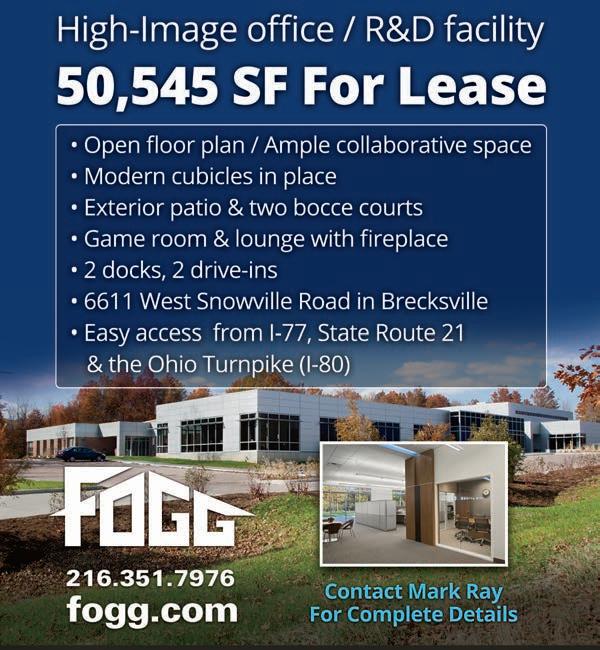








 BY RAY LEACH
BY RAY LEACH
Earlier this year, the White House delivered a procla mation designating November National Entrepreneur ship Month. I wholeheartedly believe in the power of entrepreneurship to transform communities. Re ecting on nearly 20 years as CEO of JumpStart, a nationally rec ognized entrepreneurial support organization, I’ve expe rienced rsthand the impact entrepreneurs have on the cities and regions they call home.

Startups and small businesses not only bene t indica tors of economic health, job creation, revenue genera tion and tax contributions, but they also disrupt and transform industries, moving the needle and solving in novation-related problems.

Beyond the traditional tech founders and small business owners, entrepreneurship is alive and well in our corpora tions and institutions, where researchers and creative intra preneurs are developing life-changing innovations and ac celerating e ciencies in how we work and live.







National Entrepreneurship Month acknowledges busi ness owners and innovators’ vital role in our economy. is recognition also reinforces current federal initiatives to elevate entrepreneurship across the United States. For example, the American Rescue Plan Act, signed in March, reauthorized the State Small Business Credit Initiative v2, which will provide $10 billion to democratize access to startup and small business capital and technical assis tance across the U.S. and, most notably, in underserved communities. And for a local example, the U.S. Treasury recently announced funding whereby Ohio entrepreneurs will have access to $182 million in capital to advance their small business or tech startup.

JumpStart was one of the rst venture development organizations in the United States, building a high-im pact tech ecosystem by leveraging public, private and philanthropic resources. Over the past two decades, we’ve learned much from our successes and pivots.









With a renewed focus on entrepreneurship and new funding on the horizon, what will it take for our communi ties to maximize state and federal funding to strengthen our support ecosystem and accelerate the growth of entre


preneurship across Northern Ohio?

Commitment — A cohesive and supportive ecosystem depends on the dedication and dedicated re sources from leaders across sectors. Entrepreneurs, researchers and cor porate innovators need access to the same things to start and scale: capi tal, high-impact technical and com mercialization services, and connec tions to clients, investors and industry experts. With an established support network at the intersection of entrepreneurship, founders and innovators can access the resources they need to navigate from idea to launch.
Collaboration — Everyone has a role to play in build ing a thriving entrepreneurial ecosystem, from founders ready to bring ideas to life to advisers and investors eager to be part of the next big thing, from corporations willing to pilot new ideas to talented teams excited to contribute to an entrepreneurial endeavor. Our communities can achieve substantial economic growth when we come to gether to support local startups and small businesses.
Capital — If it takes a village to raise an entrepreneurial ecosystem, it takes capital to drive it home. Northern Ohio is poised to compete with peer regions across the country, but we need a substantial in ux of funding to attract and main tain job-generating, revenue-creating companies. Federal funds will soon be available to support historically discon nected communities, and access to considerable venture capital investment will accelerate our economic growth.
Northern Ohio is ready for its next chapter, and we are poised to fully leverage new capital opportunities to achieve our collective vision for a cohesive and thriving innovation economy. We have an established ecosystem of entrepreneurial support organizations, including MAGNET, Bounce, OAI and others. In addition, our re gion is home to long-standing academic, philanthropic and research institutions and globally revered health care systems. With greater collaboration among state wide institutions than ever before, I am encouraged by the momentum of our entrepreneurial ecosystem.
In December 2007 I sold all my interest in Burke Lake front Services (BKL) dba “Million Air Cleveland.”
Million Air was a successful company, and it had both a past and a future. I was, at the time, the company’s sole owner. Million Air BKL’s business was focused on the avi ation segment called “general aviation.” Only a few years prior to selling, Million Air BKL received general avia tion’s most noteworthy recognition — selection by the National Air Transportation Association’s “Distinguished Service to Aviation” recognition.
at of which I speak was then, and much has changed. Unfortunately, the animus directed at Burke Lakefront Air port by the uninformed has not changed. I have defended Burke on many instances and I presume this communica tion will follow suit. Allow me to state my position succinctly and emphatically. Burke Lakefront Airport should remain a general aviation airport but should be administered by peo ple who know and understand general aviation — and not by political operatives that are still trying to do what every other mayor has tried to accomplish, sell or redevelop Burke for uses which do not comport with reality.
ere are practical reasons why Burke should remain an airport:
1) Burke Lakefront Airport was developed, in great part, on an unregulated land ll. ere is no continuity as to what is found underground. I can tell you, Cleveland’s streetcar tracks, bus tires and virtually everything and any thing one could imagine is buried there. Two things I can
say with certainty are: a) since I had numerous soil borings taken on the airport’s premises, I can say for the most part the “load bearing” substrata begin around 75 feet below the soil’s surface; and b) when runway lights were installed at Burke the electrical workers, who were installing the un derground lights, had to wear hazmat suits because of the degree of soil toxicity found. What that means is that if one were to excavate at Burke, the massive disposition of con taminated excavated material would present an inordi nate expense for the site’s developer.

2) Burke Lakefront Airport has never had a visionary land use plan prepared. One need not worry about sub soils if all you’re going to have on the site are aviation buildings, runways and grass. e city’s mayors and air port commissioners refused to look at how the airport can be grown — not how it can be disassembled.
As the largest employer at Burke, I can tell you that I sim ply stopped trying to set up a meeting with the mayor. Clear ly his time was far more valuable than mine.
I learned a long time ago that if one seeks to “stand out,” establish a unique point of di erence between your prod uct or your service and those of your competitor. What ma jor city in the country has a reliever airport as proximate to the downtown hub than Cleveland? I can answer that for you: “None that is a true point of di erence.”
We are blessed that in Cleveland we have three major suppliers of aviation parts. Do you think that a Cleveland mayor has ever called on the CEOs of the parts suppliers I mentioned and asked them, “How can we in Cleveland better serve the aviation needs of your company’s eet of corporate aircraft?”
No need to answer if your mind is made up. e question has never even been thought of, let alone asked. omas P. Slavin
Gates Mills
NOVEMBER 14, 2022 | C R AIN’S CL EVELAND B USIN E SS 9
PERSONAL VIEW OPINION
Ray Leach is CEO of JumpStart Inc.
will it
AKRON +1 330 535 2661 MEDINA +1 330 239 0176 OUR TEAM WORKS FOR YOU CLEVELAND +1 216 831 3310 www.naipvc.com www.pleasantvalleycorp.com BUILD. LEASE. BUY. SELL. MANAGE. LETTER TO THE EDITOR Burke should remain a general aviation airport
DIVVY HOMES FINDS SUCCESS
The rent-to-own startup has purchased more than 1,100 properties in Cleveland, according to a Crain’s analysis. PAGE 14
LAYING A F O UNDATI ON
Making the case for a career in construction for Cleveland women


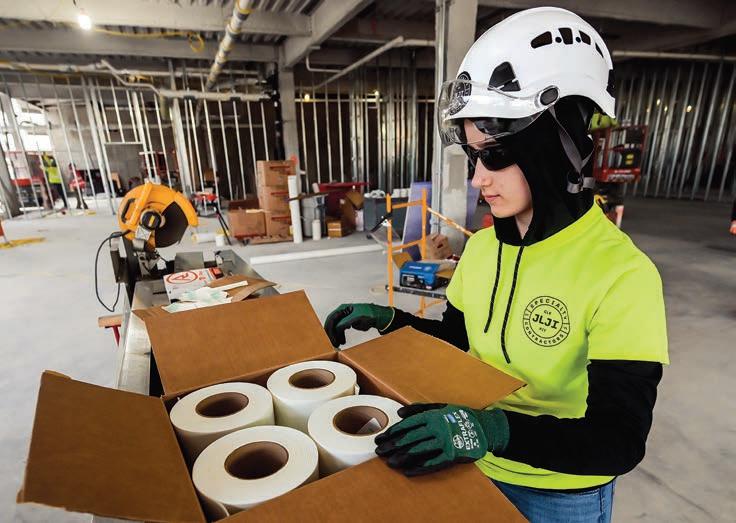
In late October, U.S.
BY | KIM PALMER
10 | CRAIN’S CLEVELAND BUSINESS | NO VE M BER 14, 2022
REAL ESTATE
Laborer Supattra Trappenberg works at the MetroHealth construction site.
Commerce Secretary Gina Raimondo announced at the Tradeswomen Build Nations conference in Las Vegas that the Biden administration was launching Million Women in Construction, an initiative to recruit and employ 1 million more women in the construction trades, doubling current numbers, over the next decade.
Carpenter Faith Kalman works at a construction site for a MetroHealth building in Cleveland.
Plumber Doreen Cannon demonstrates a technique at the Plumbers Local 55 training center in Cleveland.
PHOTOS BY KEN BLAZE FOR CRAIN’S CLEVELAND BUSINESS
at aggressive goal is needed, as more than $1 trillion in unprecedented federal infrastructure spending, coupled with a shortage of trained tradespeople, presents a once-in-a-generation opportunity to increase the paltry 11% female representation across the construction industry, Raimondo said.
Attracting more women into a career in the building trades will necessitate those women already working in the construction industry to help dispel the stereotypes and stigmas associated with construction work, said David Wondolowski, Cleveland Building and Construction Trades union executive secretary.
“ e most e ective way to recruit women into the trades is to have women who have been doing it explain the bene ts and provide mentorship,” Wondolowski said. “It is those women who have the ability to articulate the advantages of being in the building trades and make other women feel that they can be part of this industry.”
In Cleveland, at least two women are doing just that.
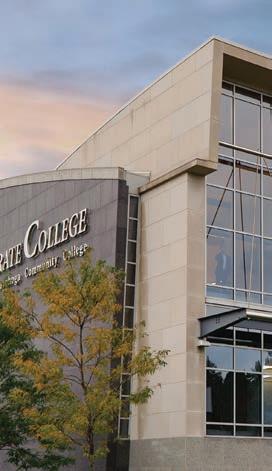

A much-needed sounding board


In 2014, Doreen Cannon, a recently retired union plumber with nearly three decades of experience under her belt, founded Cleveland Tradeswomen, a recruiting, mentoring and support group for women in the trades.




“When I got into the industry, 25 years ago, women made up just about 2% of all trade workers,” Cannon said. Since then, the number of women working directly in the trades — plumbing, electrical and masonry — is up to nearly 4%, which, despite being an increase, does not come close to representing the number of women participating in the overall workforce.



e Cleveland Tradeswomen committee, Cannon said, provides a much-needed sounding board for issues that arise for women working in such a male-dominated eld. “We support each other. We mentor each other,” Cannon said. “ e women who have been in the business




for a long time we pair up with new apprentices to provide a bit of a sounding board for concerns.”

Construction trade work is a natural t for women, Cannon argues, because it requires the critical skills women tend to excel at, such as multitasking, problem-solving and collaboration.
“But when you drive by a construction site, you don’t see a lot of women,” Cannon said. at lack of representation makes it harder to recruit other women, who, Cannon points out, might nd it overwhelming to be the only woman on a job.
e paucity of female workers on job sites often means there are no bathrooms for women, safety equipment is not available in their size, and Cannon has heard stories of female apprentices relegated to menial, non-
skilled tasks rather than given opportunities to learn new skills.
“I hear all the time from tradeswomen that they'll be on a job, get to know the crew, and just when everybody realizes they can do the work,
the job’s over and they have to move to a new job with a di erent crew where they have to prove themselves all over again,” Cannon said.
NOVEMBER 14, 2022 | CRAIN’S CLEVELAND BUSINESS | 11
FOCUS | REAL ESTATE 20-0846 Our team will create a safe and innovative experience for your organization. • Business-focused environment • Experienced event planning team • Hybrid meeting technology • State-of-the-art venue • Best-in-class customer service • Award-winning catering Plan your next event at our world-class facility corporatecollege.com 20-0846 CC - Facility Ad Series 6x6.indd 1 10/20/20 2:05 PM Ideal Multi-Tenant/Office Building >> Industrial Zoning with Many Allowable Conditional Uses >> Can Accommodate 2 or 3 Stories LAND FOR SALE: Beacon West, Westlake CONTACT US Charles Marshall 330-659-2040 3457 Granger Road, Akron, OH 44333 VISIT OUR WEBSITE www.beaconmarshall.com Property Features •Price for 6.69 lot is $580,000 •One Lot Left • Quick Access to I-90 and Crocker Park • Enterprise Zone • Major Business and Retail Area • Stormwater Pond Installed • Build to Suit Availability
Sheet metal worker
works
Cannon PHOTOS BY KEN BLAZE FOR CRAIN’S CLEVELAND BUSINESS See CONSTRUCTION on Page 12
Pipe tter Chiela Wade cuts a pipe at the Plumbers Local 55 training
center in Cleveland.
Amanda Bold
at the MetroHealth site.
e tradeswomen group makes foremen aware of issues that face women, while also working to make the industry a better place for women by simply trying to increase the number of female workers in all parts of the industry.
“What I always say, when I’m asked, ‘What can we do to change the perception of the construction industry, and make it more attractive for women?,’ is that one answer is to just bring in more women who will tell you what you need to get rid of and what is not working for them on these sites,” Cannon said.
With that in mind, the tradeswomen group actively recruits women looking for a career pivot or students who don’t think a four-year college degree is for them.

Jobs in the trades on average pay twice as much as minimum-wage jobs in hospitality or retail and are some of the highest-paying jobs women can get without a college degree. Cannon adds that union construction jobs provide guaranteed wage parity regardless of gender, because all jobs are bound by the speci cs of long-term contracts.






“We always talk about these apprenticeship programs as the other fouryear degree, because you go to school but in the end there is no debt,” Cannon said. “Where else can you go and get a job and know what you're going to be making in four and ve years and have guaranteed annual pay raises?”




Providing support and guidance

As more women and younger generations are being recruited to join the construction industry, studies




like Deloitte’s 2022 Gen Z and millennial survey released this August show that 23% of respondents from both generations said that a diverse and positive workplace culture are top reasons they chose to work for their current organization.



“Our industry is de nitely being encouraged to reevaluate and reconsider the future of construction from a diversity and inclusion standpoint,” said Keeley Williams, project engineer at Gilbane Building Co. “ ere is a pivot to bringing in more women into the


eld, and our group wants to make sure that it is a positive place for women and that we are considered valued members in our industry.”





Williams, a recent architectural engineering graduate from the University of Cincinnati, started empoWer, Gilbane’s rst employee resource group focused on support, leadership and career development for women in the Cleveland o ce.



Employee resource groups, or ERGs, like Gilbane’s empoWer are made up of speci c, often underrep-
resented groups of workers within a company. e groups, which include one focused on younger workers, women, veterans, LGBTQ employees and employees of color, provide professional and social support and guidance from peers on career and personal development within Gilbane and in the construction industry.
Gilbane, which is headquartered in Providence, Rhode Island, has 45 o ce locations around the world, including in downtown Cleveland. It currently has about one-third of its 3,000 employees participating in one or more diversity ERGs, which, according to a report by the company,

are a major part of a plan to increase racial and gender diversity at the company by 50% from 2020 to 2030.
EmpoWer is similar to the union’s tradeswomen group but includes the 11% of female employees that work across the construction industry, including architects, engineers, managers and administrators.
Williams, who decided to work in the construction eld after a stint as an intern at Gilbane, where she was mentored by another female employee, stresses that one of the most critical bene ts empoWer provides is simply “celebrating women in construction with words of encouragement.”

12 | CRAIN’S CLEVELAND BUSINESS | NOVEMBER 14, 2022
FOCUS | REAL ESTATE Quality Service You Can Trust Windsor Metal Roofing is a standing seam metal roofing company recognized for our expertise and unparalleled attention to detail. A standing seam roof has the ability to transform the look of your home and is able to withstand the harsh weather conditions typical of the Northeast region. Our track record of high-quality projects has built us a reputation for short lead times and quick turn arounds. Mark Wengerd, Owner Cell: 440-321-9434 Office: 440-313-5799 Financing Options Available RESIDENTIAL | COMMERCIAL | INDUSTRIAL SPECIALIZING IN STANDING SEAM
Left: Sheet metal worker Amanda Bold talks with project superintendent Joe Schilens and Dave Wondolowski. Right: Project engineers Taylor Watson, from left, Ti any Fante and Rachel Webb talk at the MetroHealth consstruction site.
CONSTRUCTION From Page 11
Williams
Highlighting prominent female leaders in the eld, she said, is im portant because it fosters an environ ment where women are comfortable coming to one another to talk about any problems they're facing.
“I was intimidated as a woman coming into construction. And if it were not for people supporting me and the mentorship at Gilbane, I don't think I would have even looked at the industry for a career at all,” said Williams, who added that with the help of mentors she has al ways felt “respected and appreciat ed and valued.”
e growth in the number of projects, and the number of women
on those construction projects, is helping change perceptions and is making the construction industry “extremely attractive for women, both in management as well as in the trades,” Williams said.
Now, when she goes out to schools on recruiting events, Wil liams said about 50% of the class looking to learn about the industry is made up of female students.



















“ ere is a lot of growth in the market here in Cleveland, and there is a lot of work to go around,” she said.

Kim Palmer: kpalmer@crain.com, (216) 771-5384, @kimfouro ve
BY KEN BLAZE FOR CRAIN’S
CBRE leader bolts for Industrial Commercial Properties
STAN BULLARD
In a surprise move, CBRE needs a new leader for its Northeast Ohio of ces after Keith Brandt resigned to join Industrial Commercial Proper ties of Solon.




Brandt was named market leader for the global real estate services and brokerage company’s Cleveland and Akron o ces just 20 months ago. He has joined Industrial Commercial Properties as an executive vice presi dent. e move was e ective Mon day, Oct. 31.
Brandt said he is excited to join ICP because it “was a rare opportunity to join a local organization that has a great growth model. Op portunities to join great leadership teams in my backyard are very rare. I wanted to capitalize on it.”

Brandt, previously an ex ecutive for the former For est City Realty Trust of Cleveland and a veteran of the Richard E. Jacobs Group of Westlake, said his experi ence managing malls will play a part in his work at ICP.
“With the retail business and malls going through wild times, and my ex perience, we can capitalize on change in that realm," he said. "It’s a case of a national presence with ICP and a more active dealmaking role. I can’t speak more highly of CBRE as an organization and its people. It has nothing to do with CBRE and more with me.”


Chris Salata, ICP chief operating o cer, said Brandt is “one of the most accomplished real estate exec utives in Northeast Ohio. He has ter ri c national relationships from his tenure at Forest City and Jacobs. As we expand our footprint at a national level, he will play a key role.”
Salata said ICP is diversifying its portfolio with other property types as it expands beyond its Ohio and Mich igan base, although industrial real es tate remains “our bread and butter.”
ICP’s conversions of the former City View Center open-air shopping center in Gar eld Heights to Highland Busi ness Park, and Chapel Hill Mall in Akron to a mul titenant industrial proper ty, are typical of areas where ICP sees openings for growth nationally and that match Brandt’s back ground. Salata noted he has also known Brandt for more than 20 years. e idea of his joining ICP came up in passing at a personal meeting, both men said.

Mike Copella, CBRE market leader for Ohio, Michigan, Kentucky and Pittsburgh, will serve as the market leader for the Cleveland-Akron o ces on a temporary basis. It is a role he played for a time following prior North east Ohio market leader David Brown ing’s move to step back from manage ment to brokerage on special projects after heading the company’s presence for more than 30 years.
“I’m ready to step in because I’m
very familiar with both o ces and their operations,” Copella said. “I also serve as the broker of record for CBRE in Ohio. is has also been the best year revenue-wise for the two of ces.” However, he declined to dis close speci c sales gures.

Copella said he will work with lo cal leadership in brokerage and property management to select a successor for Brandt.
“It could be someone from the in side or from the outside,” Copella said, and not necessarily a realty veteran. “I would say we like people who are pas sionate leaders that deeply care about the community and care about elevat ing our brand. We’ll cast a large net to nd the best leader available.”
At ICP, Brandt joins a sta peopled with executives with corporate real es tate backgrounds, particularly from the former DDR Corp. (now SITE Centers). ICP’s portfolio includes 46.5 million square feet of property in six states.
“We’re on track to add another 20 properties this year,” Salata said. ICP is owned by Chris Semarjian, a former real estate agent who has developed ICP over the past decade after holding individual properties earlier.
Brandt’s period leading CBRE in Northeast Ohio has been quiet. e sole exception to that was the exit of a high-pro le broker with the rm, Conor Coakley, for the locally owned Cushman & Wake eld brokerage in Independence.
Stan Bullard: sbullard@crain.com, (216) 771-5228, @CrainRltywriter
NOVEMBER 14, 2022 | C R AIN’S CL EVELAND B USIN E SS | 13 FOCUS | REAL ESTATE
With 2.4 million visitors over the past 12 months, Tower City has welcomed more than 20 new businesses, updated the food & beverage experience and opened the picturesque Skylight Park on the concourse level. Schedule a tour today to see what’s new at Tower City!
Retail + Food & Beverage Space Available THE TIME IS NOW. THE PLACE IS TOWER CITY.
Simply
to
| 440 473 1115
services offered through Sequoia Financial Advisors, LLC,
investment advisor. Registration as an investment advisor does not imply
certain level of skill or training. More information about Sequoia can be found here:
SCAN THIS TO SCHEDULE A MEETING
For leasing inquiries, contact: Beth Azor 305-970-0416 | beth@azoradvisoryservices.com
For over thirty years, the team at Sequoia Financial has been assisting clients craft personal financial plans that achieve their unique goals.
put, we’re here
help. SEQUOIA-FINANCIAL.COM
Investment advisory
an SEC-registered
a
https://adviserinfo.sec.gov/
Brandt
PHOTOS
CLEVELAND BUSINESS
Rent-to-own customers chronicle Divvy Homes’ successes, growing pains
MICHELLE JARBOE
Mat and Amber Harkless joke that they were the last couple in America to buy a house without a bidding war, just before the market exploded in 2020.
Despite high credit scores and no debt, the couple couldn’t get a mort gage. ey were self-employed, build ing a client base for their edgling sa lon, Exodus Hair and Barber Lounge in downtown Cleveland. eir busi ness was too new, lenders said.
So the couple turned to Divvy Homes, a West Coast startup that of fers clients who aren’t quite mort gage-ready an on-ramp to ownership. e company lets customers pick a property on the open market, with some limits. Divvy pays cash, and cli ents rent while preparing to buy.
In February 2020, Divvy bought a four-bedroom bungalow for the Hark lesses in the city’s Kamm’s Corners neighborhood. e couple rented for 15 months, until they quali ed for conventional debt. In June 2021, they purchased their house for just over $170,000, paying 4.8% over Divvy’s original price at a time when home values were skyrocketing.
“Truthfully, I don’t know what we would have done if we hadn’t heard of Divvy,” said Amber Harkless, who is 32.
With their lovingly maintained home and their dogs, Tucker and
Roxy, the Harklesses could be a post er couple for Divvy’s rent-to-own program. Founded in 2017, the San Francisco-based company positions itself as a force for good in a long-sor did segment of the real estate indus try.

Since choosing Cleveland as one of its rst two markets (the other was Atlanta, a safer bet in the view of in stitutional investors), Divvy has pur chased more than 1,100 properties in Northeast Ohio, according to a Crain’s analysis of public records spanning 15 counties.
e company is expanding its inhouse brokerage team, which has an o ce in Independence, and is plan ning to bring its new title company to Ohio. A possible joint venture with a mortgage lender, to ease clients’ transition from renting to owning, is on the horizon.
“I want Divvy to be a platform where, from the rst rental to the last home you own, we’re providing ser vices along the way,” said co-founder Adena Hefets, the company’s CEO, during an interview at the Cleveland Marriott Downtown hotel in April.
A new model
So far, though, the verdict on Divvy is mixed.
“ ey help you realize what you’re taking on in the whole situation. It’s a great program to keep you moving in
that right direction,” said Steve Dun lap, who is renting from Divvy for the second time after he and his wife de cided that the rst house they picked no longer suited them.
Now, the local health insurer you know and trust can offer you superior dental benefits with one of the largest networks in the country.
“ ey put us in a house that we wanted to be in. But everything else … it wasn’t a good experience for three years here,” said John Lovelace III, a customer who is suing Divvy af ter his purchase of a home in South Euclid fell through.
Local real estate agents say the company is lling a critical need, one that will only grow as soaring interest rates put homeownership further out of reach for rst-time buyers and low- to middle-income families. But some clients and watchdogs argue that Divvy, fueled by venture capital and yet to turn a pro t, isn’t fully liv ing up to its mission of making real estate — and the generational wealth-building opportunities it pro vides — accessible to all.
An article in the November issue of Fast Company magazine focuses on tenants’ complaints about mainte nance at Divvy’s properties and ar gues that the business model puts customers at risk. In an open letter, Hefets challenged that assertion but acknowledged that her team is striv ing to improve.
“Divvy is successful when our cus tomers are successful,” she wrote in a post on the company’s website. “ is is the core tenet that underpins Div vy’s business model. … Until we’ve reached 100% of our customers buy ing their home from Divvy, we still have work to do.”
reinforcing inequities in the housing market. “We need a stronger set of corporate practices and stricter regu latory oversight to make alternative nancing a meaningful pathway to homeownership,” the report con cludes.
Divvy says that, so far, half of its cli ents who nish a lease actually buy their homes. In the Cleveland area, the conversion rate is comparable, said Lucia Franzese, the company’s chief revenue o cer.
“I would say 50% is pretty impres sive,” she said during an early No vember meeting at a co ee shop on Cleveland’s West Side. “All the people who signed a lease couldn’t qualify for a conventional mortgage.”
Northeast Ohio remains one of Divvy’s largest markets, though the company is growing faster in other metropolitan areas, including Dallas, Houston, Orlando and Tampa, Flori da. Hefets won’t discuss the size of the company’s portfolio, beyond say ing that Divvy has purchased thou sands of properties across the coun try and helped “well over” 500 customers become homeowners.
Pros and cons
Learn how Ohio’s health and dental experts can keep your employees smiling. Visit MedMutual.com/Together, call 1-800-409-2595 or talk to your broker.
Compared with old-school rentto-own models, which led to ram pant evictions, shoddy living condi tions and cost-burdened tenants, Divvy and its new-breed competitors o er buyers much more support, ac cording to a recent report from the TechEquity Collaborative, an organi zation focused on housing, work force and labor issues.
But rent-to-own contracts still are complicated, the authors note. ere are pitfalls for consumers and risks of
e rst crop of tenants in the Cleveland area reached their buy back deadlines last year. Some bought early. Some extended their leases. Others moved because of job changes, births and other major life events. And some left because they fell out of love with their houses.
Hefets laughingly compares those situations to a relationship, where couples date and move in together before deciding on marriage. Divvy gives clients a road map to a pur chase but the wiggle room to opt out. Tenants’ rent payments include a savings component — $200 to $500 a month, typically, on a $200,000 home
14 | CRAIN’S CLEVELAND BUSINESS | NO VE M BER 14, 2022 FOCUS | REAL ESTATE
Mat and Amber Harkless with their dogs, Tucker and Roxy, on their front porch in Cleveland’s Kamm’s Corners neighborhood. The Harklesses worked with Divvy Homes, which uses a rent-to-buy model, to purchase their home. | GUS CHAN FOR CRAIN’S CLEVELAND BUSINESS
— to build toward a down payment.
Customers who change their minds leave with that money, after paying a 2% fee. When tenants move out, Divvy puts another rent-to-own client in the home or decides to sell it o .
“ ere are pros and cons to the program. It’s not for everyone and every situation,” said Carly Sablotny, an agent at Keller Williams Living in Solon. “I would never encourage someone to utilize the program if they can nance. It’s just going to be more expensive.”
When the Dunlaps moved into a four-bedroom Divvy home in Medina in February 2018, they needed room for three additional family members. In early 2021, they added a year to their lease. By early 2022, everyone else had moved out. And the house felt like too much space and expense.
e couple left with their accrued savings, about $25,000, and moved into a traditional rental. After a few months, though, they decided to go back to Divvy. ey signed a lease on a three-bedroom home in Parma in September, a $225,000 house they aim to own within a year.
“Our family changed, and the market changed dramatically over time,” said Dunlap, 47, a district manager for an environmental-services company. His wife, Julie, is a nurse. “ e nice thing with Divvy is it allowed us to have exibility to really have that soul-searching conversation.”
In Lorain, Jason Arbour stumbled onto Divvy in late 2017 while searching for alternative nancing online.
Demoralized by credit challenges and tired of renting in North Ridgeville, he and his wife, Shelli, became the company’s rst clients in Northeast Ohio.
Arbour also extended his lease by a year, after running into nancing delays as a lender tried to get comfortable with Divvy’s process. He reluctantly agreed to a higher rental rate and acquisition price as part of the revised contract. e family bought the home on Dec. 30, 2021.
“Anybody that’s listening to Divvy’s marketing and falling for this beautiful narrative of how homeownership can be within grasp of people — it’s not as easy as they make it sound,” he said. “But it’s doable. It’s legit. ey’re not trying to scam people.”
Divvy paid $78,000 for that house in 2017. Four years later, the company sold it for just over $108,000. During that period, the median sale price for a single-family home in Lorain rose 74%, according to data from the Red n brokerage.
“You have to be committed,” Arbour, 50, said of entering a rent-toown deal. “You have to say, ‘Come hell or high water, I’m going to get through those three years.’”
Rolling out changes
is year, amid rising interest rates and economic uncertainty, Divvy rolled out changes to let renters auto-renew and rent long-term. e company also is allowing clients to opt out of the savings portion of their
rent. “I don’t think you should be forcing a mom of two to save when grocery prices have gone up as much as they have,” Hefets said in October.



And Divvy is exploring ways to communicate with customers more quickly and clearly — both at the outset and during the landlord-tenant relationship. at includes looking at how the company can help people who apply for the rent-to-own program but don’t meet the minimum requirements, including a credit score of 550 and a monthly household income of $2,500.
Lovelace, the client who is suing Divvy, hopes to nd a way to keep the house where he and his family have lived since mid-2019. “I love it to death. I don’t want to leave it,” he said. “ at’s why we’re doing what we’re doing right now.”
His lawyers claim that Divvy failed to execute on a purchase agreement signed in May, after Lovelace and his wife lined up a mortgage backed by the Federal Housing Administration.

In a response led last month in Cuyahoga County Common Pleas Court, Divvy asserts that Lovelace could not get a loan because of late rent payments, credit issues and bankruptcy lings.
He and his wife did le bankruptcy in late 2019, to shed some debt in the hope of becoming homeowners within a few years. Lovelace sought bankruptcy protection again in June 2020, to block an eviction. Divvy has initiated, but dropped, eviction cases against Lovelace twice, court records show.

Christopher Wetherbee, a Medina attorney representing Divvy, said the company does not comment on pending litigation.

“Divvy closely examines any situation in which a customer is anything less than fully satis ed with the outcome of their relationship with Divvy. As a result of this close attention, we are con dent that this matter will be resolved appropriately once the reality of the situation is demonstrated by the evidence,” he wrote in an email.

A 39-year-old maintenance worker, Lovelace changed jobs in the spring. His wife also works in building maintenance, at a nearby church. ey rented a house in East Cleveland before moving to South Euclid. ey have three children and have never owned a home.
During the coronavirus pandemic, after losing part of their income, the couple turned to a rental assistance program to cover their payments — just over $1,800 a month, with $365 of that going toward equity, court records show.
In the spring, the family had more than $14,000 in savings with Divvy, Lovelace said. But they’ve been living in the house rent-free for months, eating into that balance, as the case plays out. “We’re just holding tight right now,” he said. “We basically have put everything we’ve got into this.”
Michelle Jarboe: michelle.jarboe@ crain.com, (216) 771-5437, @mjarboe
NOVEMBER 14, 2022 | CRAIN’S CLEVELAND BUSINESS | 15
FOCUS | REAL ESTATE Your legacy helps
a healthier community. At University Hospitals, we take our commitment to our community seriously and are grateful for your ongoing support in this rapidly changing world. Together, we’ll continue to treat patients like family, find new treatments and cures, and prepare the next generation of caregivers. Join others who are helping advance the science of health and the art of compassion by leaving their legacy. To learn more, contact our Gift Planning Team: UHGiving.org/giftplanning | 216-983-2200 Leave your legacy. Remember University Hospitals in your estate plans.
create
JOBS
COMPANIES GET CREATIVE
Employers nd new ways to attract and retain workers
JAY MILLER
Talan Products Inc. em ploys 85 people and hopes to expand in the next few years.
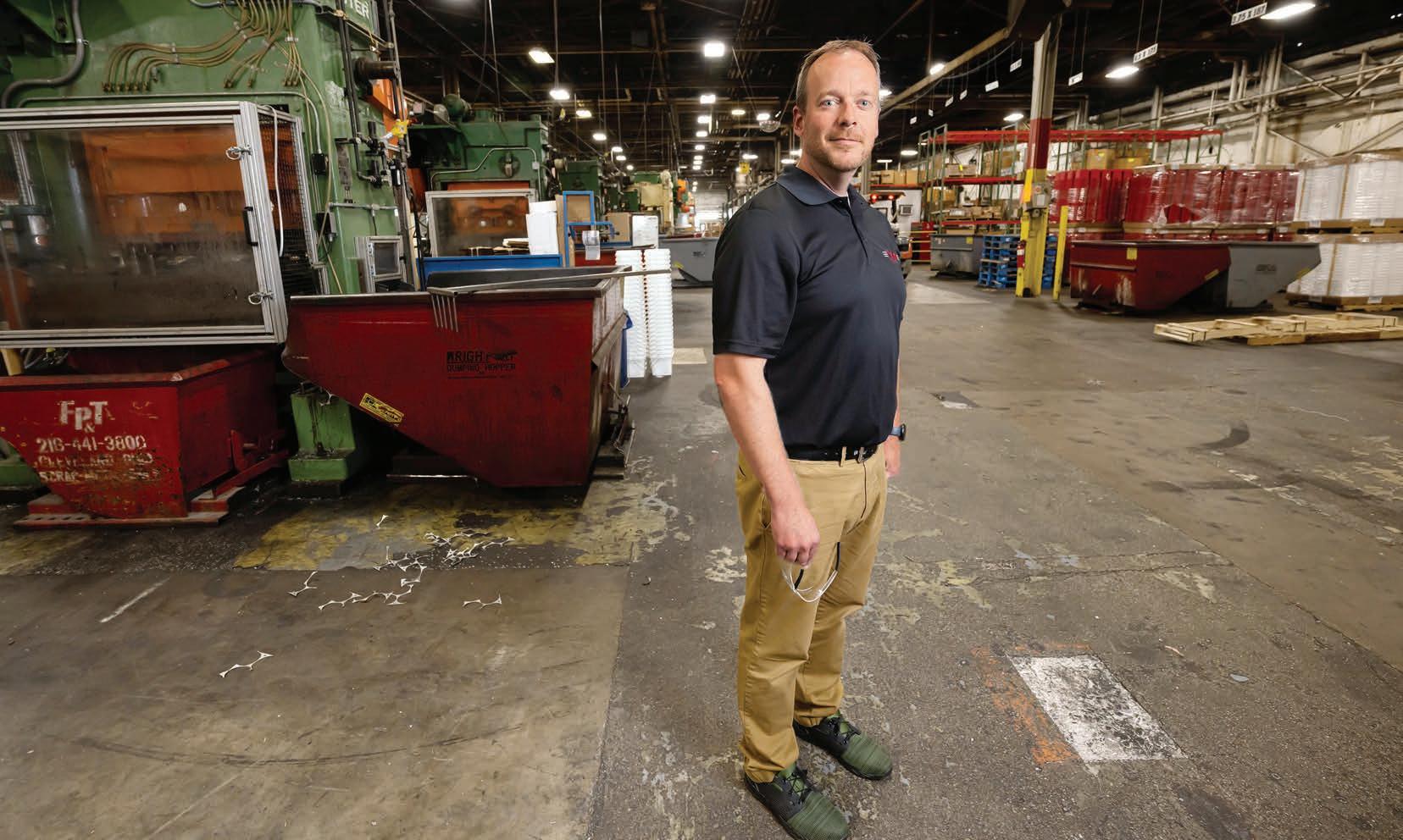
at may not be easy at a time when there is about one person looking for work for every two job openings in the United States, according to the feder al Bureau of Labor Statistics August Job Openings and Labor Turnover Survey.

Talan is a 36-year-old metal stamp ing rm in Cleveland’s Collinwood neighborhood. It makes automotive stampings, a variety of specialty washers for a number of industries, and products for the construction in dustry. And it’s begun making prod ucts for the solar and LED lighting industries.
It’s added 20 workers this year, and COO Adam Snyder knows that, with 30% of Talan’s existing workers older than 55, the company is looking at a
raft of retirements. It hopes to reach 100 workers in the next few years, if it can attract enough of the right workers.
“ ey just need to be good,” Sny der said in an October interview.
e COVID-19 pandemic pushed many people to leave their jobs, but it’s not the only reason employers are struggling to nd workers. Early re tirements and a slowdown in immi gration are also factors. And the busi nesses and nonpro ts that provide child care and elder care to working families have lost workers, as well.


at has meant they’ve had to cut back on services, forcing some of their clients, who have children or elderly parents to care for, to quit their jobs.
An article in the October Harvard Business Review laid out the future in no uncertain terms.
e article “Competing in the New Talent Market” starts this way: “Many business leaders are asking when the workplace will get back to normal. If by normal, they mean ‘2019,’ the short answer is ‘never.’”
16 | CRAIN’S CLEVELAND BUSINESS | NO VE M BER 14, 2022
PAGE 19
PAGE 19
PAGE 20
‘GOOD JOB’ MAKES THE DIFFERENCE: Workers are often overlooked by typical recruitment e orts.
HOW TO FIND GREAT PEOPLE: Manufacturers struggle with a talent gap; investment can help.
BE AN ‘EMPLOYER OF CHOICE’: Program designed to help employers hold on to their employees
SPONSORS
Adam Snyder is COO of Talan, a 36-year-old metal stamping rm in Cleveland’s Collinwood neighborhood.
| PHOTOS BY KEN BLAZE FOR CRAIN’S CLEVELAND BUSINESS
Arshayla Jones works at Talan.
A push for exibility
To expand the pool of candidates, Talan is changing the way it runs its production oor. With its growth spurt, it began building a second shift that picked up when the rst shift ended at 4:30 p.m. But now, with hir ing getting harder, it’s nding new ways to attract people who can’t work those shifts.
“We found that 6:30 to 4:30 wasn’t an ideal shift time for everybody,” said Snyder. “And we were getting feedback from the market that some people are looking for less than a full shift.”
In response, the company added half shifts with one running 6 a.m. to 1 p.m. and another from 4:30 to 11 p.m.
“We had some folks say, ‘Hey, that 6-to-1 works really well because I need to be home to get my kids o the bus,’ while others have been at tracted to the 4:30 p.m. to 11 p.m. shift,” he said. “ ey say, ‘You know, my signi cant other works rst (shift), so I can work like a retail eve ning shift.”
Gig work has become attractive. A recent study by the Pew Research Center called “ e State of Gig Work in 2021” found that 3% of U.S. adults were full-time gig workers. e U.S. Chamber of Commerce de nes gig workers as “independent contractors or freelancers who typically do shortterm work for multiple clients.” ey delivered food or other products for services such as Door Dash and Am azon Flex, performed household tasks like house cleaning or furniture assembly or were selling via a mobile app or website.
“ e worker-employer contract is changing — fundamentally and per manently,” wrote Katy George, a se nior partner and chief people o cer at McKinsey & Co., in the Harvard Business Review. “ is will likely re main the case even if the economy continues to struggle, because the roles and skills where the ght for tal ent is ercest will still be in demand.”
A recent survey by the manage ment consulting rm Korn Ferry uses a big number to emphasize the im balance. “ e $8.5 Trillion Talent Shortage” said that by 2030 the lack of workers with the right skills could mean that 85 million slots worldwide will go un lled.
Northeast Ohio’s challenges
While the Harvard Review looked nationally and Korn Ferry looked globally, reporting locally tells a sim ilar story. It’s especially true in indus tries where employees can’t work re motely, including manufacturing, health care and the construction in dustry — all major employers in Northeast Ohio.
Michelle Collins is executive direc tor of Conxusneo, a Summit County workforce intermediary that works to improve the skills of the workforce and bring job seekers closer to em ployers in the Akron area. She said her organization, which focuses on the manufacturing, health care and infor mation technology sectors, is working to help employers think about how they can be an employer of choice, a place that will be an attractive place to work. In particular, she is telling em ployers to listen more closely to what employees need from their employer.
“So really listen to your employees, understand what your employees value, and then nd ways to create an environment that is responsive to your employees,” she said. “We’re communicating that to as many em ployers as possible.”
e numbers are clear, however, that employers face an uphill battle to ll open slots.
A study earlier this year from the Fund for Our Economic Future laid out the numbers for the 18 Northeast Ohio counties it focuses on. e Future Fund is using the study to help employers and employees nd solutions.
In 2021, there were 1,637,893 peo ple in jobs in Northeast Ohio — 95,510 fewer than in 2019, representing a 5% decline in the number of employed people since the start of the pandem ic. “Where Are the Workers” surveyed nearly 5,000 workers and more than 600 employers across Northeast Ohio and found that most face worker shortages and their workforces are ag ing, becoming more diverse and not making enough money.
e study said 408,313 had quit their jobs in the previous year. It found that while a good wage was very im portant or somewhat important for 98% of the workers surveyed, other factors were also important. Having what was described as “meaningful work” was important to 92% of those surveyed. Flexible hours were import ant to 90% and paid time o was a fac tor for 88% of respondents.
Time and again people contacted for this story echoed those ndings, emphasizing that nding and keeping workers is more than pay and bene ts. e employers and workforce nonpro ts said employees and job seekers cited a number of factors that fall under the umbrella of company culture as important to where they work. at included o ering paid pa rental leave to new parents, changing shift hours or o ering training that leads to advancement.
Finding the right people may also mean expanding the candidate pool by being more intentional about di versity. According to Indeed.com, “Diversity in the workforce refers to the individual characteristics employ ees have that make them unique.
ese characteristics can include gen der, race, ethnicity, religion, age, sexu al orientation, physical abilities and ideologies.”
Number of unemployed persons per job opening
to nd the best schedule, the best pay, et cetera,” she said. “Or they’re picking new career elds outside of health care because many individuals can work from home or remote and we can’t always o er that in health care because we’re taking care of patients. And then, retirement, of course.”
Construction incentives
e problem in the construction industry stems from the boom in commercial building.
David Wondolowski, executive di rector of the Building & Construction Trades Council, said construction projects planned or underway — such as the Sherwin-Williams Co. headquarters and at the area’s major hospitals — means construction rms can expect to face ve years of worker shortages. His association represents 12,000 tradespeople who belong to the council’s 29 local unions — bricklayers, carpenters, electricians and more.
Glen Shumate, executive vice president of the Construction Em ployers Association, which rep resents rms that use union con struction workers, agreed with Wondolowski about the increase in demand and added that the building boom in Central Ohio, which in cludes Intel, will draw tradespeople away from Northeast Ohio. Shumate said that if Intel or some of the other big projects in Central Ohio need workers, they might pay higher-earn ing tradespeople an $8-$10 an hour premium.
“If you can get a 25% bump in your pay for an hour and a half drive or commute, you may go down there,” Shumate said. “I do know companies who have already lost project manag ers to (out-of-town) work.”
It may also mean looking at hiring the formerly incarcerated. Employers can nd a number of organizations to help navigate these issues. Most coun ties in Northeast Ohio have reentry o ces and the Northeast Ohio Reen try Coalition and Towards Employ ment also help employers ll en try-level and semi-skilled positions. Snyder, who previously worked on the “Where Are the Workers” study and its recommendation at the Future Fund, said Talan “is pulling every le ver.”
For Talan, that has involved, for ex ample, participating in the Manufac turing Sector Partnership of Work force Connect, a development e ort funded by the Deaconess and Gund foundations, Cuyahoga County and other public and private partners in Cuyahoga Coun ty. It’s an e ort to connect more workers to well-paying career paths and help em ployers nd the skilled tal ent they need. So far, it is targeting three employment sectors — manufacturing, health care and information technology.
e ACCESS to Manufac turing Careers program of Workforce Connect targets reentry for people looking for work after leaving the jus tice system.
But there is more to Talan’s talent hunt than that.
“We’re involved with some of the school-based programs to drive
awareness (especially targeting) grad uating high school students,” Snyder said. “And we’re involved with multi ple recruiting and sta ng companies to try and nd the right candidates. We’ve had every net out.”
Keeping workforce levels up, of course, is not just a manufacturing problem. Just the particulars are dif ferent.
Mobility in health care
Area hospitals, for example, are having a hard time keeping sta , es pecially nurses, from moving on, of ten just to another local hospital.
ey’re lured by hiring bonuses, a more attractive shift or a di erent work environment — like leaving an emergency room job for one at a long-term nursing facility.
e hospitals are also competing with the compa nies that o er what are called health care profes sional travel contracts, where nurses and other al lied professionals take short-term assignments mostly in hospitals around the country, even around the world, that pay considerably more than lo cal rates.

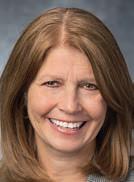
e No. 1 reason employees leave University Hospitals, said Kim Shel nik, vice president for talent acquisi tion, is to go to a competitor.
“ ey move because they’re trying
But again, it’s not just a pay issue. Shumate said he heard from one member contractor who told him about a package to entice workers that includes opportunities for ad vancement and leadership training. e contractor also said the company was planning to increase wages to help workers pay for child care and adding a 5 to 11 p.m. half shift to at tract someone who was part of a working couple or someone who works a full-day shift but wants an extra paycheck.
Another said it was o ering paid maternity leave, and a third, a high way contractor, was doing its rst-ev er job fair in Akron.
Rethinking requirements
Another way employers need to rethink their hiring plans is about the educational experience they require.
William Gary, Tri-C’s executive vice president for workforce, com munity and economic development, said that 65% of the in-demand jobs require some form of post-high school education, but not necessarily the four-year bachelor’s degree that employers may put on a job posting.
“Why do we have these arti cial gatekeeper sort of credentials?” he asked. “Ultimately you have people with the experience that have done the work in places where they didn’t need those credentials that are talent that (an employer) could acquire if you reexamine some of these gate keeper credentials.”
NOVEMBER 14, 2022 | C R AIN’S CL EVELAND B USIN E SS | 17
20082010201220142016201820202022 0 1 2 3 4 5 6 CRAIN’S CLEVELAND BUSINESS GRAPHIC
SOURCE: U.S. BUREAU OF LABOR STATISTICS Seasonally adjusted
See WORKERS on Page 20
The No. 1 reason employees leave University Hospitals, said Kim Shelnik, vice president for talent acquisition, is to go to a competitor.
Shelnik
For workers, it’s a ‘good job’ that makes the di erence
JILL RIZIKA
e Fund for our Economic Future’s “Where Are the Workers” report characterized the cur rent NEO workforce as “aging, more diverse and not making enough money.” Team NEO’s 2021 Misaligned Opportunities report notes that minority workers, and in particular Black workers, were underrepresented in all aspects of preparation for and access to higher paying in-demand jobs.
ese reports point to the urgent need to fo cus on a) investing in supportive on-ramps to prepare young talent, talent of color, and other untapped pools of talent for access to in-de mand jobs, and b) making more jobs “good jobs” that embrace the presence of a more di verse workforce.
A “good job,” according to the Aspen Insti tute, is one that o ers three key things: eco nomic stability (family sustaining wages and bene ts, fair reliable scheduling, safe working conditions), economic mobility (clear path ways to advancement, wealth building oppor tunities) and opportunity for equity, respect and voice.
Towards Employment works with 2,000 peo ple a year seeking economic mobility though a “good job” who in many cases have been over looked by mainstream recruitment e orts. Most have low incomes but bring assets that
belie the typical characteri zation of “low skilled.”
Some are working to obtain their rst job or re-tool after a long absence from the la bor market. Others are looking to improve their cir cumstances by advancing or moving on to a “good job.”
Take Timothy, a young man who had a di cult start to life, with neither of his parents able to provide stability or support. He was homeless, and had a crimi nal history and no job experience. But Timothy had a GED and motivation to change his cir cumstances. With the right supports, he gained both technical and soft skills, accessed stable housing and health services, and built a reliable social network as he paved a new life for him self.
He is now a full-time worker at a local manu facturer who has created a supportive culture for individuals with challenging backgrounds, recognizing Timothy’s potential.
What can employers and workforce system partners do to nd new talent like Timothy and create these kinds of pathways to a good job?
Invest in supportive on-ramps: Supportive
e talent pipeline is broken; how to nd great people anyway
 BY ETHAN KARP
BY ETHAN KARP
Manufacturers have been struggling through a talent gap since Blockbuster reigned su preme, but we’ve yet to nd our Net ix-level disruption.
Short of creating great workers in a lab, I’m not sure something so immediately tide-turn ing exists. I’ve worked with hundreds of small manufacturers as head of nonpro t consultan cy MAGNET, and as their sales grow, each comes upon a di cult realization: Finding great people to drive their business forward is downright di cult.
Today, within Northeast Ohio’s manufactur ing industry alone, we’re short 10,000 to 12,000 workers. And for high-growth companies in any industry, talent is always, always, always a chief concern.
Long term, our way out is by xing the whole system and better connecting the folks (em ployers) who need workers with the organiza tions who have access to them (schools, social organizations).
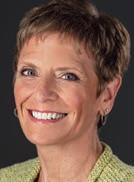
My work chairing the Cleveland/Cuyahoga Workforce Development Board and MAGNET’s leadership with Greater Cleveland Partnership of a manufacturing sector partnership is fo cused on making those connections, and I’ve been encouraged to see progress.
nd us, not the other way around. But the talent we need is often hidden in plain sight, especially peo ple of color and women who are dramatically un derrepresented in manu facturing. It takes us work ing with the system to build new on-ramps for these folks.
We’ve had success doing so at MAGNET, where we’ve worked with employers and schools to establish the Ear ly College, Early Career program. High school juniors and seniors can take on apprentice ships at area manufacturers while earning col lege credit. Afterward, they’re often rewarded with full- or part-time o ers, plus free tuition as they continue to hone their skills toward ad vanced positions.

In many cases, the students had no clue what the inside of a manufacturer looked like before learning about ECEC. Now, they’re planning a life free of higher education debt, with a strong starting salary.
on-ramps bring employers and workforce de velopment organizations together to address both the “social determinants of work” and the education and skill development targeted to speci c jobs leading to family sustaining career pathways.
Just as health care is about more than medi cine, getting and keeping a job is about more than just education and skills. As Timothy’s sto ry underscores, it also depends on a host of fac tors that impact an individual’s ability to take advantage of a given job opportunity, such as safe and stable housing, reliable and a ordable transportation, and access to health care and to a ordable and dependable child care, as well as to internet services and to a social support network.
Paid training, employer-sponsored training or ongoing on-the-job training such as appren ticeships are critical as many workers cannot a ord long, unpaid training programs.
An example of supportive on-ramp pro gramming is Towards Employment’s partner ship with University Hospitals targeting talent from East Side neighborhoods. It led to a reduc tion in interview-to-hire ratios and a 10+ per centage point improvement in one-year reten tion for key entry level positions. Access to Manufacturing Careers is another. is pro gram of the Cleveland/Cuyahoga Manufactur ing Sector Partnership provides contextualized
soft skills, robust wraparound supports and employer-de ned manufacturing skills train ing targeting young people and those with re cords. ere are now three established sector partnerships working to address talent needs with a focus on equity.
Make more jobs “good jobs”: Attracting and retaining new talent and creating a more equi table economy means not just xing the “work ers” but also xing the “work.” Asking workers what is important to them is fundamental. A response to what we’ve heard from workers that is also re ected in “Where Are the Work ers” is the Employer Resource Network model. An ERN is an employer collaborative that pools resources to provide an on-the-job success coach who o ers assistance with work/life is sues to all employees.
e success coach works on site to a) address many of the social determinants of work that can cause stress and derail a worker’s perfor mance, b) provide nancial literacy and other essential training and connect workers to com munity resources; and c) support worker pro fessional development goals. For more infor mation on the NEO ERN, see www. towardsemployment.org.
Our community is at a critical juncture. We must recognize that business success is tied to creating good jobs for new pools of talent, like Timothy. Let’s get to work.
Yet as pronounced as the problem remains, it’s possible for organizations to nd who they need today. But it takes investment. at doesn’t just mean upping salaries. It also means spending time and energy to think up creative solutions.
First, companies need to stop looking for tal ent in the same places they always have. Some of us may even believe it’s an applicant’s job to
Which brings me to the second thing manu facturers struggle with when it comes to talent: awareness. We deal not only with the “dark and dingy” stereotypes of our workplaces, but also with the simple fact that many people don’t understand what manufacturers do. As an industry, it’s our job to educate and inspire. It’s this exact idea that drove us to build a new facility inside an abandoned ele mentary school in the Hough neighborhood, where we plan to give a visual and hands-on glimpse of manufacturing to thousands of stu dents and community members each year.
When it comes to pay and bene ts, I view these levers as a foot in the door with job candi dates. Market forces have pushed entry level pay upward and, today, manufacturers simply
must be competitive with the quality starting rates of places like Amazon, Target and Taco Bell. e job you’re marketing might automati cally bump up $6 an hour in three years, but it won’t mean a thing if it starts $1 an hour lower than your corporate neighbor. Candidates grav itate toward the highest starting rate their expe rience will allow.
Finally, to create a truly robust talent ecosys tem, companies should focus on building a great culture. It’s the only way to keep people around and feed a constant stream of high-quality referrals, which are often your best source of new talent.
Of course, coming out of the pandemic, em ployees expect more out of their jobs than ever. Our industry struggles with providing the re mote exibility some modern workers desire, but what we and all employers can do is give workers reason to take pride in their craft. We can frame job contributions within the larger
context of what they’re producing for society. We can allow workers ownership over their roles, looking to them for feedback and exper tise.
At MAGNET, we’ve engaged an organization named Re ection Point, which leads workplace discussion groups around short stories. ese groups cross typical hierarchical bounds, and it’s amazing how they spill over into the day to day, opening lines of communication. When people feel heard, they feel valued. When they feel valued, they stick around.
Of course, we never would’ve found Re ec tion Point if we hadn’t invested time in looking for creative solutions. Hopefully someday it will be easier, but the truth is that nding great talent today takes a lot of hard work. e orga nizations that commit to putting forth time, not just treasure, will be the ones who nd themselves the envy of their peers ve years down the road.
18 | CRAIN’S CLEVELAND BUSINESS | NO VE M BER 14, 2022
Ethan Karp is CEO and president of MAGNET.
Jill Rizika is executive director of Towards Employment.
TALENT
COLOR
MAGNET: The Manufacturing Advocacy and Growth Network is designed to look at what manufacturers need to succeed into the future, including a focus on talent and innovation. | ROGER MASTROIANNI/COURTESY
THE
WE NEED IS OFTEN HIDDEN IN PLAIN SIGHT, ESPECIALLY PEOPLE OF
AND WOMEN WHO ARE DRAMATICALLY UNDERREPRESENTED IN MANUFACTURING.
Being a bad employer is never a competitive advantage
 BETHIA BURKE
BETHIA BURKE
About a year ago, the Fund for Our Eco nomic Future (the “Fund”) and its partners launched “Where Are the Workers?,” a major e ort to understand what workers want as la bor market competition reigned supreme. In support of our analysis, we surveyed nearly 5,000 adults and more than 600 employers.
In recent months, however, even as we con tinue to regularly receive invitations to pres ent our ndings, we have begun to hear some version of the question: As job growth slows and the potential for a recession looms, how much longer will employers care about what workers want and need? My answer: ere is no labor market in which being a bad employ er is a competitive advantage.
Yes, the signi cant talent shortages over the past two years have prompted many em ployers to pay more attention to worker per spectives than before and, as job growth
2: Increase e ective wage. Real wages for the bottom half of earners ha ven’t increased all that much over the past de cade. Almost half of sur vey respondents cited “pay too low to support a family” as an extreme or moderate barrier to nd ing or keeping employ ment for themselves or people they know. What could that mean? When it costs more in gas or for child care coverage than a job pays, for example, that job isn’t worth it.

O ering a competitive wage is, as one em ployer put it, simply table stakes to attract tal ent. Employers who have reached the upper limit for year-over-year increases, however, could look to other ways to increase e ective wage by reducing the costs of getting and keep ing work.

Everyday challenges can be big barriers to employment
RENÉE TIMBERLAKE AND TANYA BUDLER
“We feel a sense of hopelessness that we will never be able to get a good paying job.”
In an incredibly tight labor market, with nearly two job openings for every person seek ing gainful employment, statements like this seem illogical until we consider the numerous barriers that impact the most marginalized people in our communities: mothers experi encing homelessness, people with disabilities, reentry citizens, international newcomers and others.
As part of United Way’s Social Determinants of Work (SDoW) Initiative, Rise Together facili tated Community Action Planning Sessions with numerous health and human services providers and recipients across Greater Cleve land to understand these barriers.

While some were unique to a speci c com munity, consistent barriers emerged across all eight conversations. Not everyone has to worry about the stigma of a visible disability or the criminal record question on an application, but we found that in every group we spoke with, lack of job exibility, child care, transportation and health care presented serious and often in surmountable barriers to attaining and sus taining work.
What we did not hear in these conversations was that people do not want to work. In fact, ev ery one of them is eager to work.
e question we’re trying to answer is how do we increase opportunities for people to es cape poverty’s generational grasp and secure living wages? From United Way’s perspective, this is a multilayered problem and, therefore, requires a multilayered approach: mitigation of the daily struggles associated with poverty (such as access to stable housing, food and safety); employer practices that enable workers to stay healthy and employed; and public poli cies that create pathways out of poverty rather than traps to fall deeper into it.
Here are several options employers have to attract and retain workers that address the four social determinants mentioned above.
1: Job exibility
Timberlake is director of economic mobility at United Way of Greater Cleveland and Tanya Budler is the founder of Rise Together LLC.

2: Child care
a. Partner with a nearby child care facility to o er your employees a subsi dized child care rate. When receiving child care assis tance as a public bene t, an increase in wages can result in a disproportional loss of child care assistance and ultimately result in a net in come loss, referred to as a “bene ts cli .”
b. Advocate with nearby child care facilities to ex tend their hours. Most child care facilities have limited hours of operation, making it nearly impossible for par ents to take good-paying jobs outside a 9-5 window. Employers have partnered with local child care facili ties through employer col laboratives like the Employ er Resource Network to start second- and third-shift child care — a huge advan tage to employers who op erate 24/7.
3: Transportation
a. O er last-mile transportation to bridge the gap between the closest bus or train stop and the workplace. Or, if you draw employees from a particular neighborhood, o er transportation from that location to the workplace.
b. Create a car repair emergency fund or partner with no-interest loan providers like HFLA or a loan/savings program like Bridges at Work through United Way of Geauga County.
4: Health care
a. Provide graduated and a ordable health care rates to all employees. Often low-wage earners pay the same as high-wage earners for employer-provided bene ts.
slows, I expect this attention will decrease. But the talent crunch is still real, the silver tsu nami demographers have warned about for years is here and happier employees are more productive anyway, so let’s keep caring.
Fortunately, many of Northeast Ohio’s em ployers don’t need much convincing. ey want to be employers of choice, asking us, “What can I do?” While what makes a good job is an entire eld of study, here are some ways to start:
1: Ask your employees what they want and need. A simple suggestion. Yet, of the employ ers who responded to our survey, though nearly 80% self-reported challenges attracting or retaining workers, only about 8% named having a way to regularly ask workers what they want and need as a top retention strate gy.
Until employers ask, there’s no knowing what may be on their workers’ minds, but the results may be surprisingly simple to respond to. One employer recently tried this tactic and told me what her workers said they wanted: free parking and a bike rack. “ at,” she said, “I can do.”
Near-term solutions may include o ering taxfree transportation bene ts or employer-funded ways to get to work like Share Mobility. is open-source tool, de signed to inform site selection, estimates the average commute time and cost per worker to a job location. On the child care front, some innovative employers in Akron are looking into buying daycare seats for employees, si multaneously increasing the likelihood of nding coverage for their workers with chil dren and decreasing the cost of the service to workers.
3: O er culture and bene ts that make space for exibility and life outside work. And mean it. A friend of mine recently left the eld of nursing. She told me “…no amount of paid time o is going to draw someone in if you can’t prove that you can use it, and, while you’re o , believe you don’t get called or guilted into overtime.” Whether it’s a exible work schedule, unlimited vacation and sick time or the ability to work from home, it’s not enough to advertise great bene ts. Workers need to believe they can use them.
To learn more, visit wherearetheworkers. com. In the meantime, be kind to your friends in human resources. It’s been a tough couple of years.
a. Implement a exible start time, so em ployees relying on public transportation don’t risk losing their jobs if the bus runs late. Some companies have implemented a 15-minute ex-start, while others ask their employees what works best for them and stagger start and end times accordingly.
b. Provide paid time o (PTO) to all employ ees. Less than 50% of workers are o ered PTO. Employees without PTO lose wages and risk losing their jobs if their child care falls through, their car breaks down, or they become ill. For low-wage workers, beyond job loss, these events can be catastrophic, leading to home lessness and other issues.
b. Provide PTO or sick time (see 1b) to cover doctor visits and sick days. When given a choice between missing work and losing income due to illness or ignoring health issues, employees often opt for the latter, potentially compromis ing their short- and long- term health. ese policies won’t entirely x the problems employers face but implementing any number of these proposed solutions will provide work ers with the necessary tools to respond to life’s everyday challenges while staying healthy and productive at work.
To learn more about SDoW, visit United Way’s website at unitedwaycleveland.org/ sdow.
NOVEMBER 14, 2022 | C R AIN’S CL EVELAND B USIN E SS | 19
Bethia Burke is president of Fund for Our Economic Future.
Renée
There is no labor market in which being a bad employer is a competitive advantage, Bethia Burke, president of Fund for Our Economic Future, writes. | GETTY IMAGES/ISTOCK
Most child care facilities have limited hours of operation, making it nearly impossible for parents to take good-paying jobs outside a 9-5 window. | GETTY IMAGES/ISTOCK
UNTIL EMPLOYERS ASK, THERE’S NO KNOWING WHAT MAY BE ON THEIR WORKERS’ MINDS, BUT THE RESULTS MAY BE SURPRISINGLY SIMPLE TO RESPOND TO.
Program shows how to be an ‘employer of choice’
JAY MILLER
For more than 100 years, Good will Industries of Greater Cleve land and Central Ohio Inc. has used its retail stores that accept donations of used clothing and household goods for resell to sup port its programs o ering job placement and training. It also helps people looking for work nd such things as transportation to the job and child care that help them meet an employer’s expecta tion that they will get to work on time, every day.
Now it’s helping its own work force meet those expectations. It has created what it calls the Good Partners Program, part of a young concept designed to help employers hold on to their em ployees in a time when workers are facing everything from a shortage of child care to a pinch in their paychecks caused by ris ing prices in groceries and at the gas pump to family health care problems. Too often, employers are finding, workers jump ship rather than ask their employers for help.
“Last year we served 14,000 people in the community through our workforce programming and through our family services,” said Mark Trew, COO of the organiza tion that serves people in 10 coun ties in Northeast Ohio. “But we also have 700 employees, and many of those employees are dealing with a lot of the same bar riers that employees with the oth er organizations are dealing with. So, what we created was an em ployee assistance program.”
It’s an example of the challeng es businesses are taking on to be come what the Fund for Our Eco nomic Future calls “becoming an employer of choice” in its recent study “Where Are the Workers.”
e Fund surveyed 5,000 work ing-age adults and talked to more than 600 employers across North east Ohio since the pandemic. It found that few employers, only 8%, were communicating closely enough with their employees to know what they wanted or need ed to succeed in their work. It also found, said Bethia Burke, presi dent of the Fund, that the pres sure on both employees and em ployers has grown.
“When we dug into the eco nomics, we found the bottom 50% of earners saw wages go up some where between 8% and 14% over the last decade,” she said. “But in ation is now at 13%, e ectively wiping out a decade of real wage gains. at is a big deal.”
WORKERS
From Page 17
He and Tri-C president Michael Baston believe business and indus try need to understand that because potential employees have options, they need to adjust their criteria.
“We try to encourage through our work to have companies reexamine those policies that really create bar riers for a lot of the targeted audi ences that they’re trying to see,” said Baston.
He pointed out, for example, the problem with a policy that says they won’t hire smokers. “But many in their existing workforce smoke when they leave the building on a break,” he said.
Tri-C o ers programs that lead to careers in elds such as ac counting, busi ness manage ment, hospitality management and nursing with either a certi cate or two-year associate degrees. Baston said many of the curricula combine short-term classroom programs of up to two years with on-the-job ex perience.
Baston also cited Tri-C programs — as well as programs at so-called coding boot camps like Cleveland’s Tech Elevator — that train people to be software developers, cybersecu rity specialists and Microsoft O ce specialists in short-term classes.
e building trades and CEA also o er training opportunities — its young Cleveland Builds pre-appren ticeship program is designed to at tract young people to their industry.

After completing the four-week pro gram, where they learn from di er ent professionals in the trades, the graduates can seek four-year ap prenticeships with construction rms where they can earn an aver age of $16 an hour and then move on to a journeyman job that the CBCTC says can pay an average of $27.64 an hour, or $58,000 a year.
Wondolowski pointed out a key attraction to apprenticeships — a paycheck while learning instead of the potential of debt from college loans.
“Even if you’re at a state school, you probably have 20 grand a year, $80,000, in debt over four years,” he said. “But in four years with the building trades, you probably make an average of $50,000 a year.”
Smaller struggles
While large employers may have the larger number of jobs to ll, small rms, too, have been chal lenged to keep sta ng up.
“We’re surviving,” said Raymond Paganini, CEO of Cornerstone IT in Mentor, which provides managed information technology services to a range of businesses. “I mean, for a while there, when, you know, every thing hit the fan, we were little short sta ed and everybody had to chip in. We had to work overtime to cover everything and, fortunately, we were able to service the clients.”
Paganini said he hired placement rms to replace sta he’s lost through the pandemic and, in addi
Change in employment
tion to the added cost of the place ment services, he’s paying 20% to 25% more in salaries than he was three years ago. He’s made other changes as well.
“We loosened our restrictions on what the (hiring) requirements were,” he said. “No longer did you have to be based in Northeast Ohio;
we were OK with going a little wider, even outside Ohio.”
He said his sta of 18 now in cludes two people working outside Northeast Ohio.
In July, Cornerstone IT was ac quired by Logically Inc., a large managed services provider base in Portland, Maine, that has made 10
similar acquisitions since 2019. Pa ganini, a serial entrepreneur, said the rising costs were not a factor in the sale; rather, it was a planned sale. He had set a goal several years ago.
“I had a goal in my mind where I wanted the company to consider be ing acquired by a large company,” he said. “So I hit that level in 2020.”
When he saw the company was over the pandemic hump, in partic ular with sta ng, he revisited his sale plans.
“I like where the new company’s going,” he said. “And they actually have a recruitment o ce.”
Casting a wider net
e sta ng shortage has also hit the more creative side of the busi ness world; jobs that, in earlier times, would see resumes ooding in.
e Rock and Roll Hall of Fame & Museum recently had nine jobs posted on Indeed.com, including one for a “Garage Musician.” e Rock Hall needs to hire several per forming musician at $16 an hour to work in its garage space, performing with guests, teaching instrument performance and participating in jam sessions.
It’s also looking for a communica tions director, security representa tives, an audio engineer and some thing called the programming and visitor engagement coordinator.
under::tech, a Cleveland mar keting rm, has ve jobs posted on its website, including for positions that support content management systems and application developers. It’s also looking to hire what it calls a web development apprentice — someone who wants a career devel oping websites.
CEO Jason errien said his 50-person rm, which has an o ce in Detroit in addition to its head quarters on Perkins Avenue in Cleveland, has hired 10 people in the last two years and has begun to consider people who live beyond those two cities to work remotely.
at’s a key part of what errien called the new “negotiables and exibles.”
Flexibles, in addition to where people live, are such things as start times and breaks in the workday once they get started.
“Especially with families, we tell them to block the time on their calendars when they’re picking their kids up from school; we never override that,” Therrien said. “And we also say we won’t try to call them during those times because that’s important to them. Now, when the kid gets home and they settle them down, they get back on.”
errien said his company has also changed how it evaluates long-distance job candidates.
“We built a matrix of how we score and look at candidates from afar,” he said. “We prefer the time zone to be Eastern or Central and, obviously, more points for being in state or within a (reasonable) drive of an of ce. But if we nd a rock star outside of that group, ne, we’ll hire them now where we would’ve never even entertained it.”
Jay Miller: jmiller@crain.com, (216) 771-5362, @millerjh

20 | CRAIN’S CLEVELAND BUSINESS | NO VE M BER 14, 2022
2% 4% Ashland County Ashtabula County Columbiana County Coshocton County Cuyahoga County Erie County Geauga County Huron County Lake County Lorain County Mahoning County Portage County Richland County Stark County Summit County Trumbull County Tuscarawas County Wayne County CRAIN’S CLEVELAND BUSINESS GRAPHIC SOURCE: U.S. BUREAU OF LABOR STATISTICS
March 2021 to March 2022
From
Lydia Tyner works at Talan. The rm has added 20 workers this year and hopes to reach 100 workers in the next few years. | KEN BLAZE FOR CRAIN’S CLEVELAND BUSINESS
Baston
See PROGRAM on Page 24
Revenue bounces back in 2021 for nonpro ts that bring crowds indoors
CHUCK SODER
Name a local nonpro t that likes to host big crowds of people indoors, and odds are they saw a huge reve nue spike in 2021.

Most of the 99 nonpro ts on the full digital version of the Crain’s Non pro ts list saw both revenue and ex penses increase straight through the rst two years of the COVID-19 pan demic, but that wasn’t true for non pro ts that rely heavily on bringing crowds of people through their doors. Many of them saw declines in 2020 followed by big increases in 2021 as pandemic restrictions eased.
Consider that the median revenue increase for the entire list was just 8.6% in 2021, but it was 34.4% for the 12 non pro ts in the arts, entertainment and recreation category. All but two of them generated more revenue in 2021 than they did in 2019.
And that gure doesn’t fully capture how big the bounceback will be. Many of those 12 nonpro ts still limited their operations in early 2021. Plus, seven of them are on scal years that end in June or September, so their revenue gures don’t re ect income increases that came later in the year when more pandemic restrictions were lifted.
A good example there is Playhouse Square. Its revenue fell 34% in scal 2020 and then dropped by another 61% in scal 2021, which ended on June 30, 2021 — just 19 days after it reopened for live performances. Likewise, its expenses also declined sharply during both years. us, Playhouse Square fell to No. 32 on the full digital list, which is ranked by 2021 expenses, after being in the top 5 based on 2019 expenses.

On the other hand, the Rock & Roll Hall of Fame saw revenue rise 193% and expenses jump 46% in 2021, push ing it up from No. 42 on last year’s list to No. 31 this year. e revenue increase is partly because visits to the museum rose in 2021 as pandemic restrictions were lifted and because it was able to host a live induction ceremony after canceling the in-person event in 2020. Of course, other factors played into that increase, as well, such as its ongo ing capital campaign and capital re ceived through programs designed to help organizations get through the pandemic, according to comments in the Rock Hall’s list submission.

Of course, COVID-19 did have a nancial impact on organizations fo cused on social services, health care or other sectors, even if it didn’t cause such dramatic swings in the data. Of the 35 nonpro ts that an swered a question asking why the data they submitted went up or down, 19 mentioned the pandemic or related programs, such as the Pay check Protection Program. A few or ganizations noted that their PPP loans were forgiven in 2021 and they counted those dollars as revenue.
Deeper data
e digital version of this year’s Non pro ts list is easily the biggest version Crain’s has ever published — but it is downright puny compared with a new list available exclusively to Crain’s Data Members: e Nonpro t Mega List.
at new list contains 1,048 North east Ohio nonpro ts, making it the sec ond-largest list that Crain’s Cleveland

Business has ever produced — just be hind the Nonpro t Compensation Mega List, a companion list Crain’s published in August that includes compensation data on more than 1,300 nonpro t executives.
While our classic Nonpro ts list is the best source for 2021 data on the region’s largest 501(c)3 nonpro ts, the Nonprof it Mega List is much broader. It includes almost every local nonpro t that les a Form 990 with the IRS, even if 2021 data isn’t yet available. Among them are tons of smaller organizations, as well as big
ger ones that aren’t eligible for this list, such as hospitals, private schools, labor unions and credit unions.
For almost all of those 1,048 organi zations the list contains recent gures for revenue, expenses, assets and em ployees, a mission statement, an in dustry classi cation and basic contact information from Form 990.

To check out both lists, visit Crains Cleveland.com/data.
Chuck Soder: csoder@crain.com, (216) 771-5374, @ChuckSoder






Your Legacy Can Advance the Healthcare Breakthroughs of Tomorrow
Gift Planning Ignites the Future of Healthcare
Create a legacy by making a difference today
Since our founding in 1921, Cleveland Clinic’s mission has been “better care of the sick, investigation of their problems and further education of those who serve.” As a nonprofit organization, philanthropy has played a significant role in a century of fulfilling this mission.
There are many ways to include Cleveland Clinic in your personal philanthropic plans. Working together, we can integrate your charitable, family and financial goals with the mission of Cleveland Clinic to transform healthcare for our patients and shape the future of medicine around the world.
Together, we can help achieve your client’s financial and charitable goals Call 216.444.1245 or email giftplanning@ccf.org.
NOVEMBER 14, 2022 | C R AIN’S CL EVELAND B USIN E SS | 21
“Coming from a research background, I’m a strong supporter of research. Cleveland Clinic is doing amazing work on neurodegenerative diseases, and I’m proud to do anything I can to support the research and help those who are suffering from these diseases.”
Scan to learn more
– DR. JEANETTE G. GRASSELLI BROWN CLEVELAND CLINIC LEGACY DONOR 2022 GEORGE W. CRILE SR. AWARD RECIPIENT
LIST ANALYSIS
Playhouse Square’s revenue fell 34% in scal 2020 and then dropped by another 61% in scal 2021, which ended on June 30, 2021 — just 19 days after it reopened for live performances. | COURTESY
EXPENSES (MILLIONS) 2021/ 2020
REVENUE (MILLIONS) 2021/ 2020
% REVENUE FROM PRIVATE CONTRIBUTIONS 2021
% EXPENSES USED FOR PROGRAMMING 2021
2021 NET ASSETS (MILLIONS)PURPOSE OF ORGANIZATION TOP LOCAL
1
CHRISTIAN HEALTHCARE MINISTRIESINC., Barberton 800-791-6225/chministries.org
$673.0 $636.6 $684.5 $633.4 98.4%98.3%$142.3To glorify God by sharing each others' medical bills
J.CraigBrownII, president, CEO 2
GREATER CLEVELAND FOOD BANK, Cleveland 216-738-2265/greaterclevelandfoodbank.org
CATHOLIC CHARITIESCORP.(CATHOLIC CHARITIES, DIOCESE OF CLEVELAND), Cleveland 216-334-2900/ccdocle.org
SIGNATURE HEALTHINC., Mentor 440-578-8200/signaturehealthinc.org
CHN HOUSING PARTNERS, Cleveland 216-574-7100/chnhousingparters.org
$106.2 $93.6 $158.5 $110.7 66.8%93.7%$90.7To ensure that everyone in our communities has the nutritious food they need every day
KristinWarzocha, president, CEO 3
$105.4 $106.9 $108.1 $108.6 33.7%79%$123.4To respond to the health and human service needs and social concerns for the people of the Diocese of Cleveland
$88.8 1 $79.5 $93.9 $90.4 ——$24.4To end health disparities in our community
JonathanLee, president, CEO
$88.2 2 $48.3 $91.4 $51.2 23.3%97.4%$29.5To leverage a ordable housing to change lives and improve communities KevinNowak, executive director
$88.1 $77.9 $88.8 $76.6 —84.5%$36.3To help people who are hurting improve their lives BrantRussell, president, CEO 7
OHIOGUIDESTONE, Berea 440-260-8300/ohioguidestone.org
JEWISH FEDERATION OF CLEVELAND, Cleveland 216-593-2900/jewishcleveland.org
WESTERN RESERVE AREA AGENCY ON AGING, Cleveland 216-621-0303/areaagingsolutions.org
9
10
11
12
MENORAH PARK, Beachwood 216-831-6500/menorahpark.org
HOSPICE OF THE WESTERN RESERVEINC., Cleveland 216-383-2222/hospicewr.org
THE CLEVELAND MUSEUM OFART, Cleveland 216-421-7350/clevelandart.org
ORIANA HOUSEINC., Akron 330-535-8116/orianahouse.org
13
14
$81.9 $76.0 $85.3 $77.2 0.9%93.2%$9.9To provide choices for people to live independently E.DouglasBeach, CEO
$84.0 $80.4 $113.0 $76.6 80.6%86.4%$498.7To preserve and enhance Jewish life in Cleveland and throughout the world ErikaRudin-Luria, president 8
$81.9 $81.9 $72.3 $79.0 4.2%76.6%$27.7To provide health care on a residential and community service basis JamesNewbrough, president, CEO
$71.1 1 $69.7 $78.5 $72.3 ———To provide hospice, palliative care, caregiver support and bereavement services WilliamFinn, president, CEO
$62.4 $64.2 $90.0 $68.8 39.8%78.2%$1,202.5To preserve and present art for “the bene t of all the people forever" WilliamGriswold, director, CEO
$61.9 $55.9 $61.8 $54.9 0%94.6%($0.1)Community corrections, substance use and mental health treatment, re-entry services
National expertise. Local talent. Certified Public Accountants and Business Advisors personally invested in the success of your business. maloneynovotny.com
COLEMAN PROFESSIONAL SERVICES(COLEMAN HEALTH SERVICES), Kent 330-673-1347/colemanservices.org
$59.2 $59.2 $61.1 $59.6 1.5%90.2%$17.3Behavioral health, crisis, addiction recovery, employment and residential services across Ohio HattieTracy, president, CEO
DIRECTION HOME AKRON CANTON AREA AGENCY ON AGING, Uniontown 800-421-7277/dhad.org $58.0 3 $57.3 $62.2 $57.6 —91.5%—To provide older adults, people with disabilities and their caregivers long-term care choices and consumer protection
15 THE CENTERS, Cleveland 216-432-7200/thecentersohio.org
16
17
18
HATTIE LARLHAM, Mantua 330-274-2272/hattielarlham.org
VILLAGE NETWORK, Wooster 800-638-3232/thevillagenetwork.org
LIFEBANC, Warrensville Heights 216-752-5433/lifebanc.org
GaryCook, president, CEO
$56.3 4 $52.9 $56.6 $56.2 —89.8% $51.3To provide life-changing and innovative health, work and family services EricMorse, president, CEO
$54.0 $50.0 $59.7 $57.8 6.9%88.7%$64.1To provide care for children and adults with developmental disabilities in Northeast and Central Ohio StephenColecchi, CEO
$52.2 $45.7 $55.0 $49.2 2.4%73.7%$28.8To work in partnerships empowering youth and families to build brighter futures
$51.3 $46.8 $55.7 $51.0 0.6%90%$41.7To save lives through organ, eye and tissue donation
19
JUDSON SENIOR LIVING, Cleveland 216-791-2004/judsonsmartliving.org
BELLEFAIRE JEWISH CHILDRENS BUREAU, Shaker Heights 216-932-2800/bellefairejcb.org
21
22
23
AKRON-CANTON REGIONAL FOODBANK, Akron 330-535-6900/akroncantonfoodbank.org
EMERALD DEVELOPMENT & ECONOMIC NETWORKINC.(EDEN), Cleveland 216-961-9690/edencle.org
GOODWILL INDUSTRIES OF GREATER CLEVELAND AND EAST CENTRAL OHIOINC., Canton 800-942-3577/goodwillgoodskills.org
$51.3 $50.0 $53.2 $49.4 5%89.6%$13.9A not-for-pro t senior living services organization serving northern Ohio
KendraUrdzik, president, CEO 20
$48.8 5 $50.9 $51.8 $49.6 6%86.5%$52.9To provide care and advocacy to enhance the physical, emotional and intellectual well being of children, young adults and their families
$48.0 3 $51.8 $63.3 $53.5 —92.7%$36.9To provide food to charitable agencies that feed people in need in eight counties
$45.1 $37.2 $38.8 $36.7 0.9%97.6%$24.7To provide housing solutions to people facing the challenges of housing insecurities and homelessness ElaineGimmel
$43.4 $34.1 $48.2 $43.1 6 12.9%89.8%$30.7Vocational and educational training
CEO 24 THE MUSICAL ARTS ASSOCIATION(THE CLEVELAND ORCHESTRA), Cleveland 216-231-7300/clevelandorchestra.com
25
STEP FORWARD, Cleveland 216-696-9077/stepforwardtoday.org
$41.9 7 $52.3 $69.4 $54.2 78.8%76.8%$288.0To inspire and enrich lives through extraordinary musical experiences
AndréGremillet, president, CEO
$41.5 8 $35.1 $42.5 $34.8 1.3%89.6%$5.5To help low-income children and families in Cuyahoga County JacklynChisholm
president, CEO 26 ST. AUGUSTINE MANOR(ST. AUGUSTINE HEALTH MINISTRIES), Cleveland 216-634-7400/staugministries.org
RickMeserini, president, CEO 27
216-361-4400/pepcleve.org
$38.1 $40.0 8.2%89.9%$26.8Post-acute care network
22 | CRAIN’S CLEVELAND BUSINESS | NO VE M BER 14, 2022
RANKORGANIZATION
EXECUTIVE
PatrickGareau president, CEO
4
5
6
JamesLawrence president, CEO
RichardGraziano president, CEO
GordonBowen, CEO
Je reyLox executive director
DanielFlowers, president, CEO
, executive director
Annemarie Richards, president,
,
CRAIN'S LIST | Ranked by 2021 expenses
ts.Colleges,foundationsandhospitalswereexcluded.Informationissuppliedbytheorganizationsunlessotherwisenoted.NOTES:
audited nancialstatements. 2. CHNreceived$47millioninEmergencyRentalAssistancegrantsin2021,upfromroughly$13millionin2020,contributingtothisincrease.
5.
6. Includes$10milliongrantreceivedinDecember2020.
2021 gures are from Form 990. Get 99 nonpro ts and +490 executives in Excel format. Become a Data Member:
POSITIVE EDUCATION PROGRAM, Cleveland
$38.0 $40.9 $37.8 $41.8 0.8%87.2%$31.0Supporting young people to overcome and thrive HabeebahGrimes, CEO 28 PRO FOOTBALL HALL OF FAME, Canton 330-456-8207/profootballhof.com $36.4 3 $32.6 $45.5 $31.1 —63.3%$36.3Honor the heroes of the game, preserve its history, promote its values and celebrate excellence JimPorter, president NONPROFITS
ResearchbyChuckSoder(csoder@crain.com) |Thislistincludes501(c)3nonpro
1. 2021 guresarefrom
3. All guresarefromaudited nancialstatements. 4. 2021 guresarepreliminary estimates.
All guresarefromForm990.
7. TheClevelandOrchestraheldnoperformancesatSeveranceHallduring scalyear2021,whichendedinJune2021,contributingtothisdecrease. 8.
CrainsCleveland.com/data
Cleveland downtown hotel lined up for local buyer
 BY STAN BULLARD
BY STAN BULLARD
Bhavin Patel and Amit Patel are discussing updates they plan to make, such as new signage and technology, for the 14- oor Hampton Inn Cleveland-Downtown even though they do not own it — yet.
e co-founders of Spark | GHC, a hotel investment fund based in Solon, said they have agreed to buy the 194-room property at the corner of East Ninth Street and Superior Avenue from an a liate of Atlanta-based Noble Investment Group that shelled out $19.3 million for it just last month, on Oct. 11.
e Patels, who are not related, said in a Zoom interview that they have terms in place from a prospective lender and expect to consummate the deal next month. However, they declined to say how much they will pay for it. Bhavin Patel said it will be “on par” with the prior deal.







































































































































































































































































































































































































































































































































































































































































































Bhavin Patel said Spark | GHC found out the property might be available and approached Noble about a deal, guring that Noble might have greater interest in other parts of the country.































































“And we have a priority to invest in our own backyard, as well as the Midwest, and a similar devotion to select service hotels and are like-minded about the Hilton brand as Noble,” Bhavin Patel said.

Amit Patel, president of Spark Ho-
tels, also of Solon, said the duo believes it is a good time to invest in downtown Cleveland’s hotel business. Spark Hotels is Amit Patel’s hotel ownership and management company. Spark | GHC re ects their joint interest in the fund; the name blends Amit Patel’s company with “GHC,” the abbreviation for Bhavin Patel’s other venture in multifamily investments.
Since late summer, the Patels have been raising a $100 million private equity fund to acquire hotels. It is no longer a question of buying distressed properties because of the rebound in the hotel operations and investment market, but they still expect multiple factors will make more hotels available the next few years.

“Our investors like that we’re going to invest in Cleveland,” Bhavin Patel said.

from the dark days of the COVID-19 pandemic has changed the outlook for the business markedly.






“REITs are buying hotels again, along with other investors,” Sangree said, “and some trophy properties like e Four Seasons in New York are selling for very high prices.”
RTicketsnow! eserveyour
“Sports events are again a driver for business in downtown Cleveland after the pandemic, and there are signs the business travel segment is starting to come back, which will drive more business in 2023 and 2024,” he said.
Bhavin Patel said the two discussed the prospective acquisition before closing because they have produced a video about Cleveland and the planned investment in the hotel that is being circulated to potential investors, and they worried news of the deal would leak.
Although it is rare for buyers to discuss deals before closing, David Sangree, president of Hotel & Leisure Advisors appraisal and consulting rm in Lakewood, said he had heard the hotel was again on the market but had not learned of the proposed Patels purchase.
“Noble bought the hotel as part of a large portfolio, so it makes sense they might want to sell some that are not in their primary markets to reduce debt,” Sangree said. “It’s a matter of them wanting to get a fair price for it. It won’t be a distressed sale by any means.”
According to online realty data provider CoStar, the Hampton here was part of a 13-property deal. e rebound of the hotel business
e Hampton Inn dates from 1996. An apartment building on the site was demolished to make way for the hotel, which was constructed by Cleveland developer John Ferchill.
Amit Patel said technologically speaking, there are ways to update the property for today’s business traveler. Such steps include contactless entry using a smartphone, knowing what streaming channels guests watch and allowing them to set the room temperature remotely.
Not all the steps they plan are necessarily sophisticated.
“We plan to restore a bar in the hotel, which we understand was very popular with guests before it was removed,” Amit Patel said. Whether they manage the Cleveland inn themselves or hire a management company has not been determined.
Bhavin Patel also is a partner in Green Harvest Capital, a Bath Township-based investment fund that has purchased more than 1,000 multifamily units in Northeast Ohio since 2019.
Noble is a powerhouse hotel concern, as it owns 170 hotels. Its portfo-
lio has a total asset value of $5 billion.
Mit Shah, Noble CEO, did not return calls from Crain’s Cleveland Business by 3:30 p.m. on ursday, Nov. 10. Noble has not returned calls or emails about buying the Cleveland property since concluding the deal last month.
Stan Bullard: sbullard@crain.com, (216) 771-5228, @CrainRltywriter
Holiday Concerts
NOVEMBER 14, 2022 | CRAIN’S CLEVELAND BUSINESS | 23
216-231-1111 clevelandorchestra.com Presenting Sponsor: WITH THE CLEVELAND ORCHESTRA AND CHORUS THE 2O22
DEC 8 - 18 WS2223-AD-Crains Holiday Ad - 10.25x7.indd 1 11/8/22 3:02 PM
REAL ESTATE
Spark | GHC, a Solon hospitality investment fund, plans to buy the Hampton in downtown Cleveland by year-end. | CONTRIBUTED
“SPORTS EVENTS ARE AGAIN A DRIVER FOR BUSINESS IN DOWNTOWN CLEVELAND AFTER THE PANDEMIC, AND THERE ARE SIGNS THE BUSINESS TRAVEL SEGMENT IS STARTING TO COME BACK, WHICH WILL DRIVE MORE BUSINESS IN 2023 AND 2024.”
—Amit Patel, co-founder of Spark | GHC
No suppliers? No problem for Kent’s R.W. Martin
DAN SHINGLER
Most rms that distributed a big, capital-expenditure product and then saw all its OEM suppliers turn away from using distributors would have probably folded. Not Kent’s R.W. Martin & Sons.
Well, that’s not entirely true — folding is, after all, literally a big part of their business. ( e company re furbishes, sells, repairs and services industrial laundry equipment.) e point being that the company didn’t give up. Against seemingly tough odds, it has thrived.
It replaced its suppliers with those manufacturers’ own products, some of them decades old, that were still in use, in the eld and in demand.
“ e industry in general went through a change. Back in 2008, we were the same basic model (various distributors). We’d have been consid ered a regional distributor for a man ufacturer,” said R.W. Martin presi dent Chip Ottman. “We’d sell those manufacturers’ equipment, and we’d provide parts and service. en all the bigger manufacturers went away from distributors. So we focused on used equipment.”
What equipment?
Washing machines, of course. And dryers, folders and a whole lot of other equipment used to wash clothes and other dirty fabrics.
Some of it is older than the techni cians who work on it. Big, cast-iron machines built decades ago still are on the job today and, in some cases, in high demand by laundries that have come to depend on them and built their systems to use them.
“Some of these things were built in 1930 or 1940. ey’re still on the mar ket and still getting the price they got 25 or 30 years ago,” Ottman said.
ese are not the pandemic-im pulse-purchase top-loaders you might have been considering. R.W. Martin works on washing machines that are the size of GE’s locomotives, not its home appliances. One model is 80 feet long.
“It looks like a really big rail car,” Ottman said.
ey have to be that big, because of
PROGRAM
From Page 20
Employers are feeling that same in ationary pressure. So they have tended to want quick solutions to their worker shortage problem. But that won’t work, the research is telling Burke.
“ e labor market reality that we’re in, that we don’t have people in certain jobs, is a (long-term) system ic reality that we’re looking for a transactional x around,” she said.
To help employers better focus, the study identi ed 10 key things they can do if they want to be an em ployer of choice:
` Pay a competitive wage
` ink beyond traditional bene ts
` Communicate bene ts clearly
` Address things that create a nega tive work environment
` Include pay in all job postings
` Incorporate exibility wherever you can ` Invest in employee career develop ment
` Help employees see meaning in their work
the amount of stu they have to wash.
eir No. 1 use is by and for hospitals, which produce prodigious amounts of soiled clothing, bedding, scrubs and other material that all has to be thoroughly washed after each use.
e Cleveland Clinic, which Ott man said uses R.W. Martin for its big machines, sends an incredible amount of material to be washed by employee-owned Ever green Cooperative Laundry in Cleveland.

“ECL currently processes about 16 million pounds of bed sheets, towels and pil lowcases for the Clinic sys tem (about 52,000 pounds a day), servicing about 90 locations a day,” the Clinic and Evergreen said in a statement on Evergreen’s website. “Evergreen also provides all pickup and delivery with a eet of nine vehi cles and ten dedicated drivers servic ing the Clinic.”
To handle that volume, they use extra-large-capacity machines.
at’s not a situation unique to Northeast Ohio, either. R.W. Martin sells its equipment and services to hospitals and their contract laun dries like Evergreen around the country, and some of its equipment is shipped worldwide, Ottman said.
` Connect to systematic e orts to support worker success
` Value employee feedback e Fund will be working with em ployers to help them build some of these things into their business models.
For Goodwill, the Good Partners Program is designed to help with some of those issues, but it is a step beyond the Future Fund recommendations. Goodwill realized, Trew said, that its employees could use some of the same services it provides job seekers.
“We wanted to bring that same lev el of service that we provide to the community, to our internal stake holders, our employees,” he said. “We have dedicated individuals that are there to act as advocates and pro vide case management services to our employees.”
Trew said Goodwill is interested in spreading the program to other em ployers in the region. “Potentially, there could be an opportunity to part ner to allow Goodwill to provide that programming to their employees.”
Jay Miller: jmiller@crain.com, (216) 771-5362, @millerjh
It’s a big business, too, because the large and complicated machines R.W. Martin deals in aren’t cheap.
“You can buy a small washer that processes 100 pounds or less of laun dry,” Ottman said. “ ose are $15,000 or $18,000. e big ones that can do from 200 to 800 pounds in a load, those can be anywhere from over $100,00 to over $200,000 or $300,000, even.” e biggest don’t even really do loads. ey’re tun nel washers that wash in a continuous fashion like an industrial process, and they can cost more than $1 mil lion, he said.
So, when Ottman and his peers tell people they’re in the used laundry-equipment business, they nd it amusing when people think of the Maytag repairman or Home De pot. R.W. Martin is really in the capi tal equipment sales and mainte nance business.
And it’s been good. e company doesn’t disclose its revenues, but Ott man said his business has been growing and his company is pro t able.
It not only has created a niche for itself in nding and refurbishing used equipment, but it has taken on a role as a builder of big, highly engi
neered facilities.
“One of the things we also do is build laundries inside VA hospitals. We’re in the middle of a large project at the VA in West Palm Beach,” Ott man said. “We’re stripping it down to nothing, bringing in all the utilities and doing the mechanical stu . It’s a turnkey project.”
Such projects represent millions in revenues, he said, and have been a major factor in driving R.W. Martin’s recent growth.
at growth has made itself evi dent as the company has invested in new facilities and people.
In 2018, R.W. Martin built a new headquarters and plant on Kent’s border with Brim eld, though Ott man said it’s actually located in an industrial park owned by Tallmadge, to which it pays its taxes.
e new building, at 34,000 square feet, is about the same size as the company’s former plant in Ravenna. But it’s more e cient and can do more than the old space, in part be cause it brings the company’s o ces and manufacturing operations under one roof. Martin’s o ces were for merly in a smaller building in down town Kent.
at was a signi cant investment, at about $3 million, but well worth it, according to Ottman.
“ e communication piece, for one thing,” he said. “Selling used equipment requires a lot of interac tion with the people working on the machines, and we didn’t have that. Before, the guys working on the ma chines were eight miles away from the guys who were selling them.”
ere are also more people that need to communicate. e company had 20 employees when it built its fa cility and today has 27.
e company announced Oct. 25 that it had hired Michael Rager as its acquisitions/inventory manager, Ste phen Keba as operations manager and Curtis Lanzer as technical proj ect manager. e position of opera tions manager existed previously, and former operations manager Matt West has moved into the role of se nior technical manager to better use his skills, Ottman said.
R.W. Martin is expanding its ca pacity
better serve its customers and also to grow. Ottman and mem bers of his management team recent ly completed Scalerator NEO, a pro gram put on by Babson College to help companies with sales of be tween $5 million and $15 million ac celerate their growth.
Ottman has plans for further growth, based on what he and his team have learned as they’ve been repairing all of that complicated equipment and installing laundries.

For example, R.W. Martin has learned a lot about how to produce, handle and deliver hot water. It turns out that has applications far beyond laundry, though.
“We now have equipment we sell into the concrete industry because in winter concrete needs to be heated when it goes into a truck,” Ottman said. “ ese are hot water systems at the cement truck loading station.”
Closer to its existing customer base, R.W. Martin is working with a European partner to put washable RFID tags into hospital scrubs. e company is developing a system hos pitals can use to automatically dis tribute and track their scrubs through automated dispensing machines.
at’s a need that’s been brought on by the pandemic. Apparently, sometimes scrubs that get taken home by doctors and nurses get snatched up by family members who work from home.
“All the health care systems bought all the scrubs they could get during the pandemic,” Ottman said. “ ey lost a lot.”
Ottman hopes the system will help hospitals reduce their costs and build closer relationships with the contract laundries that often are R.W. Martin’s customers.
Losing those OEM manufacturers from its former business as a distrib utor seems to have had a silver lining that continues to help the company today.
“We learned to be nimble and re act to the industry,” Ottman said.

Dan Shingler: dshingler@crain.com, (216) 771-5290
ON THE MOVE: Another jolt of pan demic pain hit the o ce market and downtown Cleveland as Medical Mutual of Ohio on Monday, Nov. 7, announced it will shift its headquar ters sta ers to its Brooklyn opera tions center next year. Medical Mu tual currently has 250 workers assigned to downtown, the majority of them working remotely. When downtown workers relocate in phases after Jan. 1, its sta ng in Brooklyn will reach around 900. e health insurer had said it remained committed to downtown even as it created the Brooklyn operations cen ter in space vacated by American Greetings Corp., now headquartered in Westlake. Medical Mutual leased four oors of the former American Greetings site to consolidate more than 700 workers from large o ces in leased space in Beachwood, Cop ley and Strongsville.
BUILDING BOOM: A section of Tremont’s Lincoln Heights neigh borhood that is home to three new
apartment buildings may gain yet another as a joint venture proposed a ve-story apartment building with 127 suites and 22 for-sale townhous es to start Cleveland’s planning re view process. Hanna Cohan, vice president for Concord Town ship-based Knez Homes and its a l iate Triban Development, said the company’s joint venture with Prop erty Advisors Group of Pepper Pike sought input to re ne plans as it con tinues meetings with the Lincoln
Heights block club and Tremont West Development Corp. for the 3-acre parcel. Architect Brandon Kline of Streetsboro-based de sign-builder Geis Cos. presented plans that show an L-shaped veoor building on the side of the site nearest the year-old e Lincoln apartments at Scranton Road and Willey Avenue and west of the Cleve land Animal Protective League building on Willey. Townhouses would be grouped in four buildings.
24 | CRAIN’S CLEVELAND BUSINESS | NO VE M BER 14, 2022
AKRON
to
R.W. Martin technician Francisco Medina works on a machine used to fold laundry. The company refurbishes, sells and services industrial laundry equipment. | CONTRIBUTED
Ottman
THE WEEK
Medical Mutual headquarters at East Ninth Street and Prospect Avenue. | COSTAR
RICHMAN
e onetime garment factory, which once employed more than 2,500 people, has been vacant since 1992. Since then, developers have eyed it for everything from mixed-in come housing to an indoor sh farm.

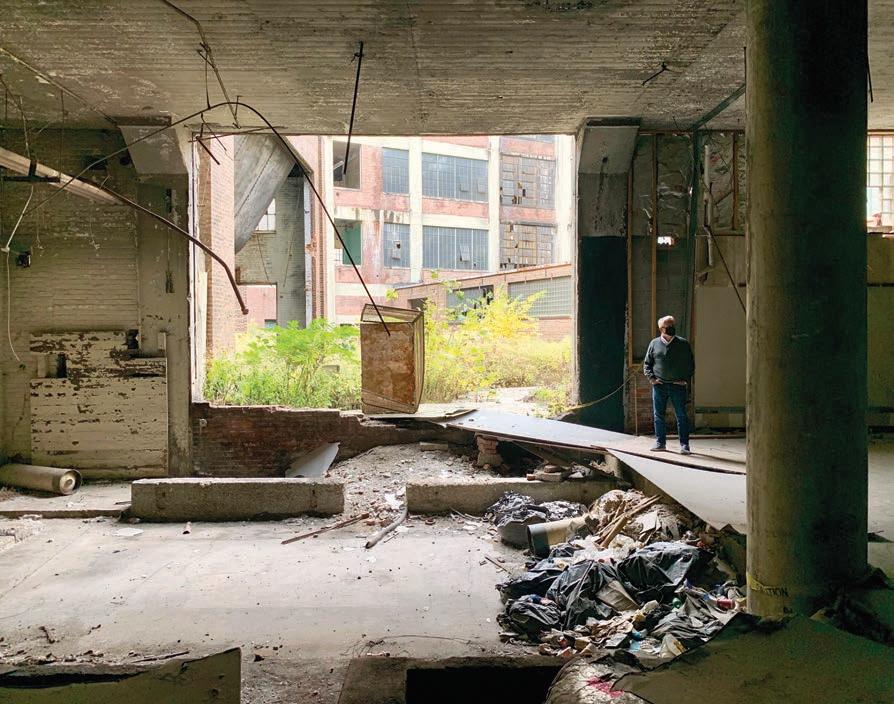

A long-term owner, CMI has de veloped apartments in New York, including preservation projects in the South Bronx and Syracuse. It’s also tackling an o ce-to-residential conversion in Pittsburgh.
“I have met with them,” said City Councilwoman Stephanie Howse, who represents the neighborhood. “I did a walk through the building, and it’s a massive structure. And I know the thought is trying to have a mixed-use property where you have some level of commercial develop ment, mixed with some housing. It’s very, very preliminary.”
Built in 1915 a short stroll south of Superior Avenue, the building has been in limbo for decades.

In 2009, entrepreneur Derek Ng bought the property for an undis closed price and pitched it to Chi nese investors as a mixed-use proj ect. But his plans never came to pass.
Two years ago, he listed the prop erty for sale through the Newmark real estate brokerage.

Terry Coyne, a Newmark vice chairman, declined to discuss the sale to CMI. He and colleague Rich ard Sheehan marketed the real es tate to manufacturers and apart ment developers.
A patient buyer, CMI isn’t likely to do anything fast. e company is evaluating potential redevelopment strategies and exploring how to nance a project in a neighborhood scarred by disinvestment.
e building, listed on the Na tional Register of Historic Places, is eligible for federal and state tax credits for preservation. e proper ty also is large enough to compete for Ohio’s relatively new tax credits for so-called transformational mixuse projects. It’s too early to say what sort of incentives CMI might seek from the city, Cuyahoga Coun
ty and other public entities.
“We’re very excited that it’s in new ownership,” said Jeremy Taylor, executive director of the St. Clair Su perior Development Corp., a non pro t group that serves the area. “We’re still trying to understand what their nal plans look like.”
Meanwhile, CMI is working to keep the building secure. City building de partment records show that the Geis Cos. of Streetsboro orchestrated fa cade repairs and addressed code vio lations earlier this year, while the property was under contract.
“It’s an important building on an important corridor, so it would be wonderful to see new life in it,” said Brandon Kline, the director of de sign development at Geis.
Howse said she expects the devel oper to listen to, and participate in, the community. Residents of nearby single-family homes are tired of blight along the wide commercial corridor, where the old Willson School building also is languishing, overgrown, across the street.
“No one wants to live next to a dump,” she said. “No one wants to live like that. e importance is be ing able to have some active reuse of a property that will be part of a solu tion — that will continue to lessen some of the negative elements that come from blighted-ness.”
A local developer, High Rock Prop erty Advisors of Pepper Pike, is study ing Willson with hopes of restoring it.
rough a collaboration with the nonpro t Western Reserve Area Agency on Aging, the company hopes to transform the nearly 72,000-squarefoot building into a ordable apart ments for seniors. e project would include roughly 110 units, some in the former school and others in new con struction next door.
“We’re in this diligence period, and we’ve looked at a number of dif ferent scenarios,” said Timm Jud son, a High Rock founder and prin cipal. “We continue to look at a number of di erent scenarios. We’d love to save the historic structure.”
Willson, a designated city land mark, was one of a dozen surplus school buildings that the city and the Cleveland Metropolitan School Dis trict o ered up to developers last year. An appraisal of the property assigned no value to the building and a $175,000 price to the underlying land.
Judson has heard chatter about the Richman Brothers building sale, but he hasn’t talked to CMI. After so many years of stagnation, there’s fresh energy in the 1600 block of East 55th. But reimagining Rich man, which previous suitors passed on or pursued as a potential tear down, is an extremely heavy lift.
“I just think the size presents an ex traordinary challenge,” Judson said.
Michelle Jarboe: michelle.jarboe@crain.com, (216) 771-5437, @mjarboe
NOVEMBER 14, 2022 | C R AIN’S CL EVELAND B USIN E SS | 25 REAL ESTATE CLASSIFIED SERVICES CLASSIFIEDS Advertising Section To place your listing in Crain’s Cleveland Classi eds , contact Suzanne Janik at 313-446-0455 or email sjanik@crain.com LEGAL ANNOUNCEMENTS ENVIRONMENTAL CONSULTING Available: Ann Arbor, MI, 20-Acre Site approved for 200-unit walkable mixed-use development. Contact Mark Evans: mdevanslaw@aol.com SPACE AVAILABLE
From Page 1
Richard Sheehan, a managing director with the Newmark real estate brokerage, stands just inside the Richman Brothers Co. building on East 55th Street in Cleveland in late 2020, left. Light oods into the fth oor of the building, right. The long-empty complex hit the market in 2020, at an asking price of $3.5 million. A New York-based developer recently purchased the mammoth factory. | PHOTOS BY MICHELLE JARBOE/CRAIN’S CLEVELAND BUSINESS
Stopping bleeding at the site at Case Western Reserve
A Case Western Reserve University researcher is looking to use nano technology to help stanch bleeding from injuries on the battle eld.
Professor Anirban Sen Gupta and his team have developed a new tech nology called “SanguiStop,” designed to allow thrombin, a “clot-promoting enzyme,” to be delivered intrave nously to a targeted location of bleeding like an internal injury, ac cording to a post on the university’s e Daily site. e body naturally produces this substance, but produc tion can be compromised in soldiers su ering severe blood loss or in pa tients who have blood defects.
“ ink of it like having concrete in place to build a dam and reduce ooding (in this case bleeding) — but you’ve got to deliver the concrete only where it’s needed, not every where in the bloodstream,” Sen Gup ta said in the post. “And that’s what we’re working on — using targeted phospholipid nanoparticles to get the thrombin where it needs to go.”
College of Wooster playing a part in uncovering Mayan history

An associate professor of archaeol ogy and anthropology at the College of Wooster is uncovering mysteries in Guatemala.
Olivia C. Navarro-Farr’s archaeo logical work in the Laguna del Tigre National Park in Guatemala’s Maya Biosphere Reserve recently led to two notable discoveries. e rst, Stela 51, is the second-earliest dated monu ment found at the site, a news release noted. e second was a royal tomb, named Burial 110. e site where these discoveries were made was a “civic-ceremonial building,” the re lease said, a location where Navar ro-Farr has served as principal inves tigator for investigations since 2003.
“We are de nitely seeing with re cent evidence that the site, political ly, was a very major player in the Ear ly Classic period and in the Late Classic period,” Navarro-Farr said in the release. “ e waves that this will make in the community of Maya epigraphy, will be signi cant. It is go ing to be a very much studied, and restudied, and restudied monument because of the texts that are on it.”
Turning plastics biodegradable at Akron
James Eagan, an assistant professor in the School of Polymer Science and Polymer Engineering at the University of Akron, is working to make plastics — and carbon dioxide — more sus tainable and environmentally friend ly.


He’s researching how to create plastics from carbon dioxide, which would then make them biodegrad able, a news release said. In the re lease, Eagan cited research noting that about 70% of current plastics are not degradable and are, in fact, capa ble of lasting for centuries.
“I want to reverse the process so that we are taking CO2 and putting it back into something, and in this case, polymers and plastics,” Eagan said in the release. “If we put more CO2 into the plastic than emitted, we can make the process carbon negative, which a very exciting possibility. In this new world, every day would be Earth Day.”
tra c, but the water contains a large, diverse community of organisms, bacteria and non-living particles like dust, soot and radioactive material riding these ows.”
Teaching the rust belt at Ursuline
Ursuline College, a woman-fo cused school in Pepper Pike, will host an NEH Summer Institute in 2023 de signed to help higher education fac ulty learn how to best share the rust belt’s story.
e National Endowment for the Humanities awarded Ursuline a grant to host “Reading, Writing, and Teaching the Rust Belt: Co-creating Regional Humanities Ecosystems” and bring 25 national scholars to the college, a news release stated. Partic ipants will visit Cleveland’s neigh borhoods and landmarks and take part in discussions based on a read ing list that grew out of a previous NEH grant to Ursuline. at grant also led to the development of an un dergraduate certi cate program, which examines discrimination, pov erty and population decline in the region, as well “social solutions,” the release said.
Hiram College helping nd the secrets to success in business
An associate professor at Hiram College is helping discover what makes some companies thrive in Northeast Ohio, despite overall pop ulation decline.
Morgan R. Clevenger, an associ ate professor of management in Hi ram’s Scarborough School of Busi ness & Communication, is a co-investigator for “Understanding High Growth Companies in Declin ing Northeast Ohio,” a research project alongside a number of fac ulty at Ohio State University. As part of the project, researchers have interviewed owners and managers at companies seeing strong growth about strategy in Columbiana, Ma honing, Portage, Stark, Summit, Trumbull and Wayne counties, ac cording to information provided by a Hiram representative.
e region around Akron, Canton and Youngstown has seen popula tion declines for decades, but hun dreds of companies across sectors have still seen strong growth in that time. e team is focusing on those that have revenue of more than $1 million, and that have doubled reve nue in three years.
Studying rainfall’s path at Cleveland State
A researcher at Cleveland State University is looking into how di er ent plants absorb or divert rainfall, as well as tracking what that rain con tains.
John Van Stan II, an associate pro fessor in the university’s department of biological, geological and environ mental sciences, is working with a team that includes researchers from the University of North Texas and Utah State University, as well as the National Center for Atmospheric Re search. e team will study a dozen sites across North America, tracking how both nutrient and pollutant par ticles are transported.
“Every time it rains, it’s essentially ‘rush hour’ in a tree,” Van Stan said in a news release. “Millions of tiny par ticles hitch a ride in the water drop lets that ow like liquid ribbons down tree trunks and drip from leaves. Human eyes may not see this
“For too long, the Rust Belt narra tive has been one of emptiness, de cay, decline, and vacancy,” said Kath arine Trostel, the Ursuline assistant professor who wrote the grant. “Our stories are often neglected in the na tional sphere or controlled by cultur al outsiders.”
Gaining back learning lost to the pandemic at Baldwin Wallace
Education professors at Baldwin Wallace University in Berea are studying how intensive tutoring could help students regain learning lost during the COVID-19 pandemic.
According to information provid ed by a Baldwin Wallace representa tive, education students at the uni versity will provide tutoring to elementary students in the Fairview Park City Schools over the next two years, drawing on funding from the state and federal departments of ed ucation. rough what the university called “High Dosage Tutoring,” the university students will o er literacy and mathematics tutoring three times a week in that time.
e program will allow the univer sity students to work with district teachers and with Baldwin Wallace faculty to design the programming and assess progress and needs in real time. e work is being led by literacy education professor Rochelle Berndt and special education professor Cyn thia Dieterich.
Connecting Stark County to the sea at Malone
A grant from the Herbert W. Hoover Foundation is helping Can ton’s Malone University teach stu dents how the health of local water sheds a ects oceans across the globe. e funding supports the universi ty’s marine biology program, along with speci c projects. ose include taking students to Florida to work with the University of Miami Shark Research and Conservation pro gram, hosting a Stark County com munity event on ocean health and giving six Malone students the chance to complete their SDI Open Water SCUBA certi cation.
Rachel Abbey McCa erty: (216) 771-5379, rmcca erty@crain.com
26 | CRAIN’S CLEVELAND BUSINESS | NO VE M BER 14, 2022
RESEARCH From Page 1
Case Western Reserve University professor Anirban Sen Gupta and his team are looking to use nanotechnology to help stanch bleeding from injuries on the battle eld. | CASE WESTERN RESERVE UNIVERSITY
Olivia Navarro-Farr has served as principal investigator at the site of an ancient Mayan building in Guatemala for almost two decades. | THE COLLEGE OF WOOSTER
John Van Stan II is studying the path rainfall – and the nutrients and pollution carried by it – takes through trees. B. THOMAS HART, COURTESY OF CLEVELAND STATE UNIVERSITY
crainscleveland.com








Publisher and CEO KC Crain

Group publisher Jim Kirk (312) 397-5503 or jkirk@crain.com

Executive editor Elizabeth McIntyre (216) 771-5358 or emcintyre@crain.com
Associate publisher Amy Ann Stoessel (216) 771-5155 or astoessel@crain.com
Director of audience and engagement Elizabeth Couch, (313) 446-0419 or elizabeth.couch@crain.com
Managing editor Scott Suttell (216) 771-5227 or ssuttell@crain.com
Assistant managing editor John Kappes (216) 771-5359 or john.kappes@crain.com

Web editor Damon Sims (216) 771-5279 or dpsims@crain.com
Assistant editor Rachel Abbey McCa erty (216) 771-5379 or rmcca erty@crain.com
Art director Kayla Byler (614) 312-7635 or kayla.byler@crain.com
Senior data editor Chuck Soder (216) 771-5374 or csoder@crain.com
Cartoonist Rich Williams
REPORTERS
Stan Bullard, senior reporter, Real estate/construction (216) 771-5228 or sbullard@crain.com
Lydia Coutré, Health care/nonpro ts (216) 771-5479 or lcoutre@crain.com
Michelle Jarboe, Enterprise reporter (216) 771-5437 or michelle.jarboe@crain.com
Jay Miller Government (216) 771-5362 or jmiller@crain.com
Jeremy Nobile, Finance/legal/beer/cannabis (216) 771-5255 or jnobile@crain.com
Kim Palmer Government (216) 771-5384 or kpalmer@crain.com
Joe Scalzo, Sports business (216) 771-5256 or joe.scalzo@crain.com
Dan Shingler, Energy/steel/auto/Akron (216) 771-5290 or dshingler@crain.com
ADVERTISING
Senior vice president of sales Susan Jacobs (312) 649-5492 or susan.jacobs@crain.com
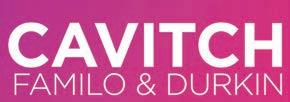

Events manager Missy Chambless (216) 771-5388 or missy.chambless@crain.com
Marketing manager Cody Smith (330) 419-1078 or cody.smith@crain.com
Sales manager Mara Broderick (917) 612-8414 or mara.broderick@crain.com
Sales and marketing coordinator Shannon Smith (440) 281-6397 or shannon.smith@crain.com
Account executives
Laura Kulber Mintz, Kaylie Moran, Hannah Sekerak People on the Move manager Debora Stein, (917) 226-5470, dstein@crain.com
Pre-press and digital production Craig L. Mackey O ce coordinator Karen Friedman

Media services manager Nicole Spell Billing YahNica Crawford
Credit Thomas Hanovich
CUSTOMER SERVICE

Customer service and subscriptions: (877) 824-9373 or customerservice@crainscleveland.com
Reprints: Laura Picariello (732) 723-0569 or lpicariello@crain.com
Cleveland Business, Circulation Department, 1155 Gratiot Avenue, Detroit, MI 48207-2912. 1 (877) 824-9373.
NOVEMBER 14, 2022 | CRAIN’S CLEVELAND BUSINESS | 27 MEET 2022’S MOVERS, SHAKERS AND RISK-TAKERS MONDAY, NOVEMBER 21, 2022 | 6:00 PM – 9:30 PM THE AGORA THEATRE AND BALLROOM TITLE SPONSOR REGISTER TODAY CRAINSCLEVELAND.COM/40S BRONZE SPONSORS CRAIN’S CLEVELAND BUSINESS
Volume 43, Number 42 Crain’s Cleveland Business (ISSN 0197-2375) is published weekly, except no issue on 1/3/22, combined issues on 5/23/22, 6/27/22, 8/29/22, 11/21/22, at 700 West St. Clair Ave., Suite 310, Cleveland, OH 44113-1230. Copyright © 2022 by Crain Communications Inc. Periodicals postage paid at Cleveland, OH, and at additional mailing o ces. Price per copy: $2.00.
changes to
Postmaster: Send address
Crain’s
Crain’s Cleveland Business is published by Crain Communications Inc. Chairman Keith E. Crain Vice chairman Mary Kay Crain President and CEO KC Crain Senior executive VP Chris Crain Chief Financial O cer Robert Recchia G.D. Crain Jr. Founder (1885-1973) Mrs. G.D. Crain Jr. Chairman (1911-1996) Editorial & Business O ces 700 W. St. Clair Ave., Suite 310,
OH
Subscriptions: 1 year - $99, Single copy, $2.00. Allow 4 weeks for change of address. For subscription information and delivery concerns send correspondence to Audience Development Department, Crain’s Cleveland Business, 1155 Gratiot Avenue, Detroit, MI, 48207-9911, or email to customerservice@crainscleveland.com, or call (877) 824-9373 (in the U.S. and Canada) or (313) 446-0450 (all other locations), or fax (313) 446-6777.
Cleveland,
44113-1230 (216) 522-1383
AT&T Business Fiber, now with Hyper-Gig speeds. Get fast and secure internet with straightforward pricing. There’s no data caps, no equipment fees and no annual contract. Limited availability in select areas. Learn more at att.com/businessfast or call 1.844.740.FAST














you get reliable
with
’re doing business like
When
internet
straightforward pricing You
a




 BY MICHELLE JARBOE
BY MICHELLE JARBOE









 BY KIM PALMER
BY KIM PALMER




































 © 2021 Benesch Friedlander Coplan & Aronoff LLP
© 2021 Benesch Friedlander Coplan & Aronoff LLP























































 BY RAY LEACH
BY RAY LEACH

































































































 BY ETHAN KARP
BY ETHAN KARP


 BETHIA BURKE
BETHIA BURKE

















 BY STAN BULLARD
BY STAN BULLARD



















































































































































































































































































